VIDEOS
Dr David Turner's fascinating and detailed account 'On the Rails' - of milk transport by rail from his 'Tracks Through Time' series (5) - The development of London's rail-based milk supply from c1840-1914.
‘The Milk Train – United Dairies’ from the ‘Doncaster Drawn’ Facebook Group, charts the history of the transport of milk from the 19th Century onwards with particular emphasis on the LMS 6-wheel milk tanker, as preserved at the National Railway Museum in York. (2023, 8 minutes)
‘Milk for London: A History of Milk Trains in the UK' from Model Railways Unlimited is a fascinating video about the history of milk transport, illustrated with model railway operations of a very high standard. (2020, 33 minutes)
Two videos 'Collecting the Milk', presented by Bob Bishop from cine film shot by John Simons capture the reality of milk transport by rail from Devon to London in the early 1970's. Part 1 shows shows a Class 22 diesel travelling the Culm Valley to collect the milk from Hemyock Creamery. After shunting the milk tanks, it passes Uffculme on its return to Tiverton Junction, before continuing to Exeter. Part 2 is filmed at Exeter St Davids, where milk tankers were marshalled from other Devon dairies/ creameries into longer trains, often 10-20 3000-gallon tanks. A larger loco hauled them to London bottling plants via Olympia and Acton yard for Unigate Ilford and Express South Morden.
See Also
Rail Operations at South Morden Dairy
RECOMMENDED READING
Matthew Pinto's superb book on railway milk traffic 'Milk On The Rails' is extensively researched and beautifully presented. It covers the complete story of how milk was transported by rail, starting with the origins of the traffic in the mid 19th Century and how it built up over many years. Rail vehicles, creameries, processing dairies and other facilities are extensively described, with brilliant illustrations. Strongly recommended, softback, 192 pages... you can order from Wild Swan Books.

'Tracks Through Time' Video Intro-Youtube: https://youtu.be/8fVrzKqf9Sg?si=hJW1sLgZnGRUtoyO
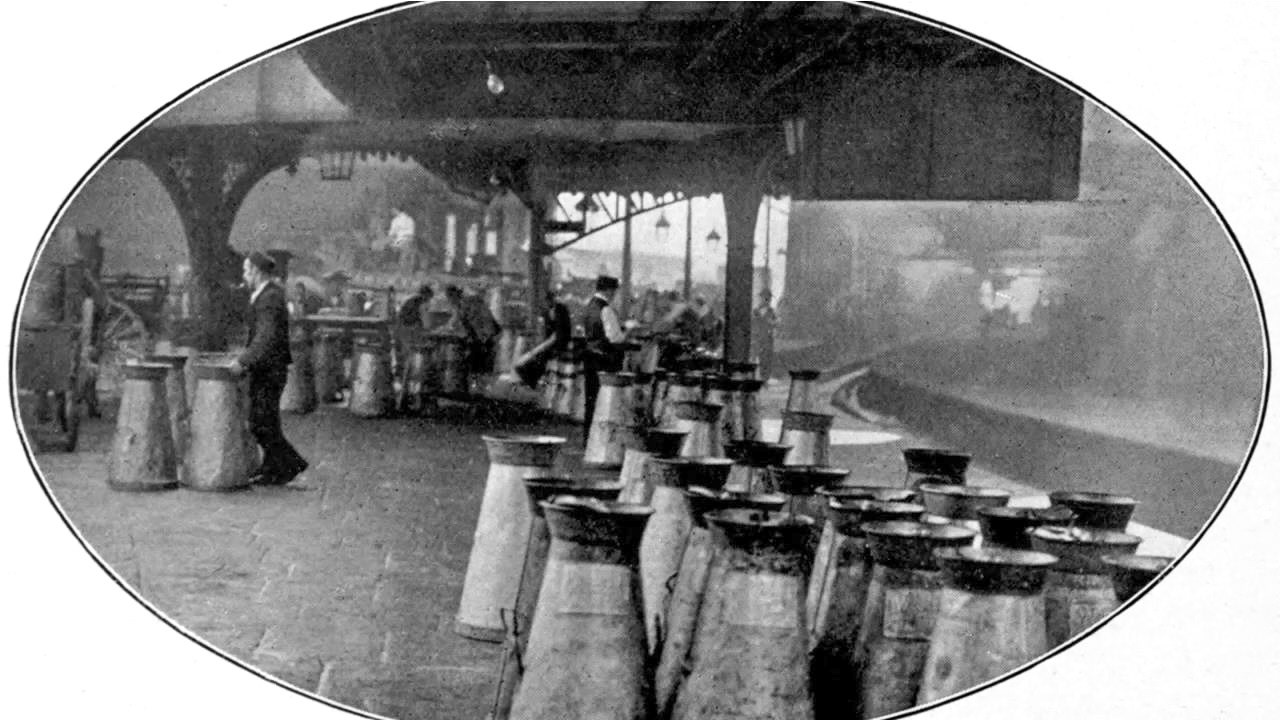
1845 milk in churns-transport of milk by train didn't start until the railways had been established for some years, and then rarely more than 20 miles from London, such as Romford, Essex. (Courtesy 'On the Milk Train' video, Dr David Turner)

1850's Milk dealers arranged milk supply by train from Essex, Hertfordshire and Hampshire. (Courtesy 'On the Milk Train' video, Dr David Turner)

1850'S Typical Urban milking shed. (Courtesy 'On the Milk Train' video, Dr David Turner)

1850'S Typical Urban milking shed. (Courtesy 'On the Milk Train' video, Dr David Turner)

1853 London's milk also came from nearby farms, such as Friern Manor Farms, East Dulwich-one of Express Dairy's farms of the period. (Courtesy 'On the Milk Train' video, Dr David Turner)

1865 Cattle plague in London seriously affected supply. (Courtesy 'On the Milk Train' video, Dr David Turner)

1865-66 Graph shows how the amount of milk conveyed into London by rail increased dramatically because of the effects of cattle plague reducing the number of cows kept in London by half, to 12,000. (Courtesy 'On the Milk Train' video, Dr David Turner)

1889 St Pancras Station Milk Dock (Courtesy Paul Flewers)
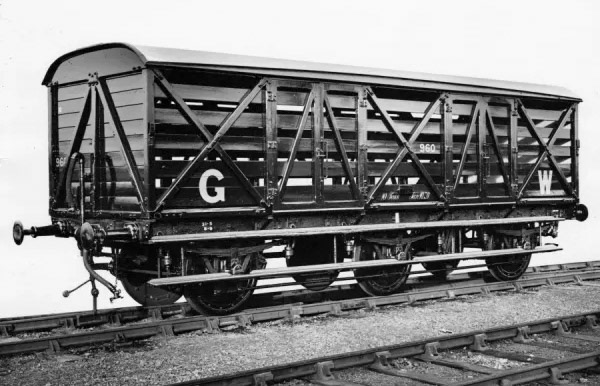
1890 Six wheeled Siphon, No 960, built to diagram O1 and designated for milk traffic. (Courtesy STEAM - Museum of the Great Western Railway)

1890's? Six Wheeled Siphon, low roof milk van, No. 1654, built to diagram O4. (Courtesy STEAM - Museum of the Great Western Railway)
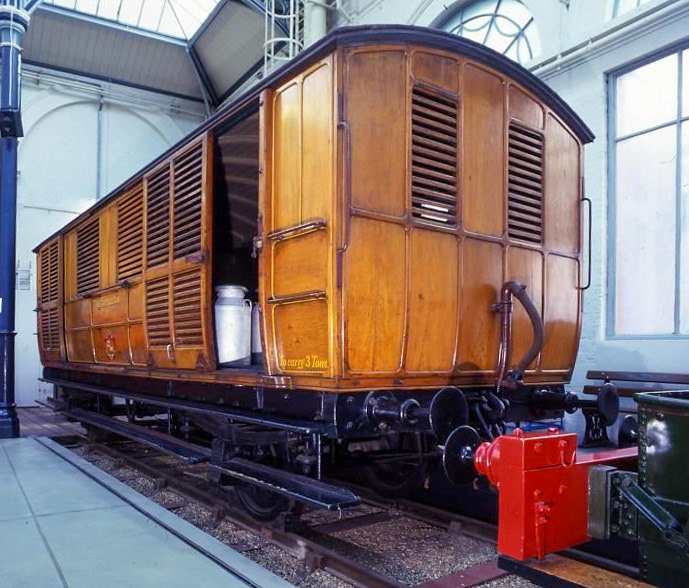
1896 Metropolitan Railway milk van No. 3. This railway van was designed to carry milk directly from dairy farms in Hertfordshire and Buckinghamshire into London. The vans were attached to fast passenger trains and each carried many large churns of milk. They were ventilated to keep the milk fresh in transit and additional suspension was added so that it did not begin to turn into butter. This milk van ran on the Metropolitan Railway from 1896 to 1936. It was overhauled in 2012 to allow it to take part in heritage operations celebrating the 150th anniversary of the Metropolitan Railway in 2013. (Courtesy London Transport Collection)

1896 Metropolitan Railway Milk Van No. 3, photographed at the London Transport Museum Depot, Bollo Lane, Acton in April 2025. "This milk van formed part of the steam trains running on the Metropolitan Railway and was used to transport milk into London from farms in Hertfordshire and Buckinghamshire. It sported wood panelling and the hand-painted Metropolitan Railway coat of arms. The car was ventilated to keep the milk fresh and the suspension was modified to prevent it from turning to butter during the journey. The milk van demonstrates the engineering solutions required even for seemingly simple tasks." Accession: 1981/540. Express Dairy Tales collection.

1896 Metropolitan Railway Milk Van No. 3, photographed at the London Transport Museum Depot, Bollo Lane, Acton in April 2025. "This milk van formed part of the steam trains running on the Metropolitan Railway and was used to transport milk into London from farms in Hertfordshire and Buckinghamshire. It sported wood panelling and the hand-painted Metropolitan Railway coat of arms. The car was ventilated to keep the milk fresh and the suspension was modified to prevent it from turning to butter during the journey. The milk van demonstrates the engineering solutions required even for seemingly simple tasks." Accession: 1981/540. Express Dairy Tales collection.

1896 Metropolitan Railway Milk Van No. 3, photographed at the London Transport Museum Depot, Bollo Lane, Acton in April 2025. "This milk van formed part of the steam trains running on the Metropolitan Railway and was used to transport milk into London from farms in Hertfordshire and Buckinghamshire. It sported wood panelling and the hand-painted Metropolitan Railway coat of arms. The car was ventilated to keep the milk fresh and the suspension was modified to prevent it from turning to butter during the journey. The milk van demonstrates the engineering solutions required even for seemingly simple tasks." Accession: 1981/540. Express Dairy Tales collection.

1896 Metropolitan Railway Milk Van No. 3, photographed at the London Transport Museum Depot, Bollo Lane, Acton in April 2025. "This milk van formed part of the steam trains running on the Metropolitan Railway and was used to transport milk into London from farms in Hertfordshire and Buckinghamshire. It sported wood panelling and the hand-painted Metropolitan Railway coat of arms. The car was ventilated to keep the milk fresh and the suspension was modified to prevent it from turning to butter during the journey. The milk van demonstrates the engineering solutions required even for seemingly simple tasks." Accession: 1981/540. Express Dairy Tales collection.

1896 Metropolitan Railway Milk Van No. 3, photographed at the London Transport Museum Depot, Bollo Lane, Acton in April 2025. "This milk van formed part of the steam trains running on the Metropolitan Railway and was used to transport milk into London from farms in Hertfordshire and Buckinghamshire. It sported wood panelling and the hand-painted Metropolitan Railway coat of arms. The car was ventilated to keep the milk fresh and the suspension was modified to prevent it from turning to butter during the journey. The milk van demonstrates the engineering solutions required even for seemingly simple tasks." Accession: 1981/540. Express Dairy Tales collection.

1900's People were also consuming more milk because of new products. From the 1870's onwards there were also developments in refrigeration, which helped rural areas, especially near railway routes, expand milk production. (Courtesy 'On the Milk Train' video, Dr David Turner)
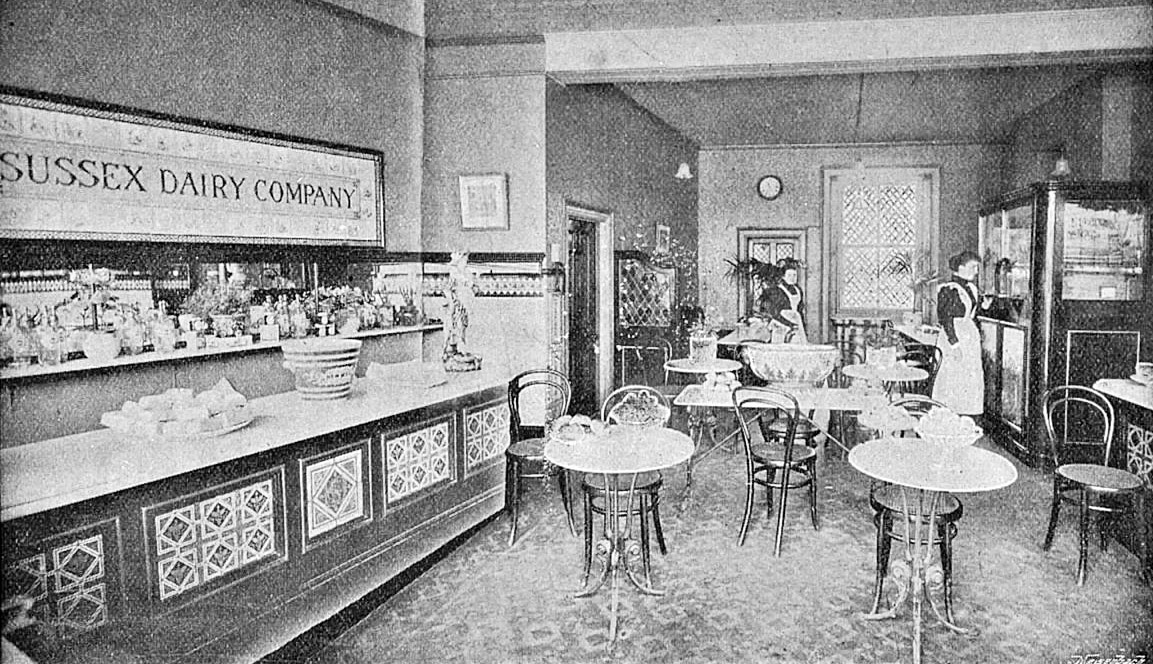
1900's Shops like this were supplied with milk brought into London by rail. (Courtesy 'On the Milk Train' video, Dr David Turner)

1900's Express County Milk Supply Company negotiated special rates to supply milk to London from Derbyshire. They also introduced the galvanised milk churn. (Courtesy 'On the Milk Train' video, Dr David Turner)

1900 Minsterley Station (Courtesy Joe Lyons)
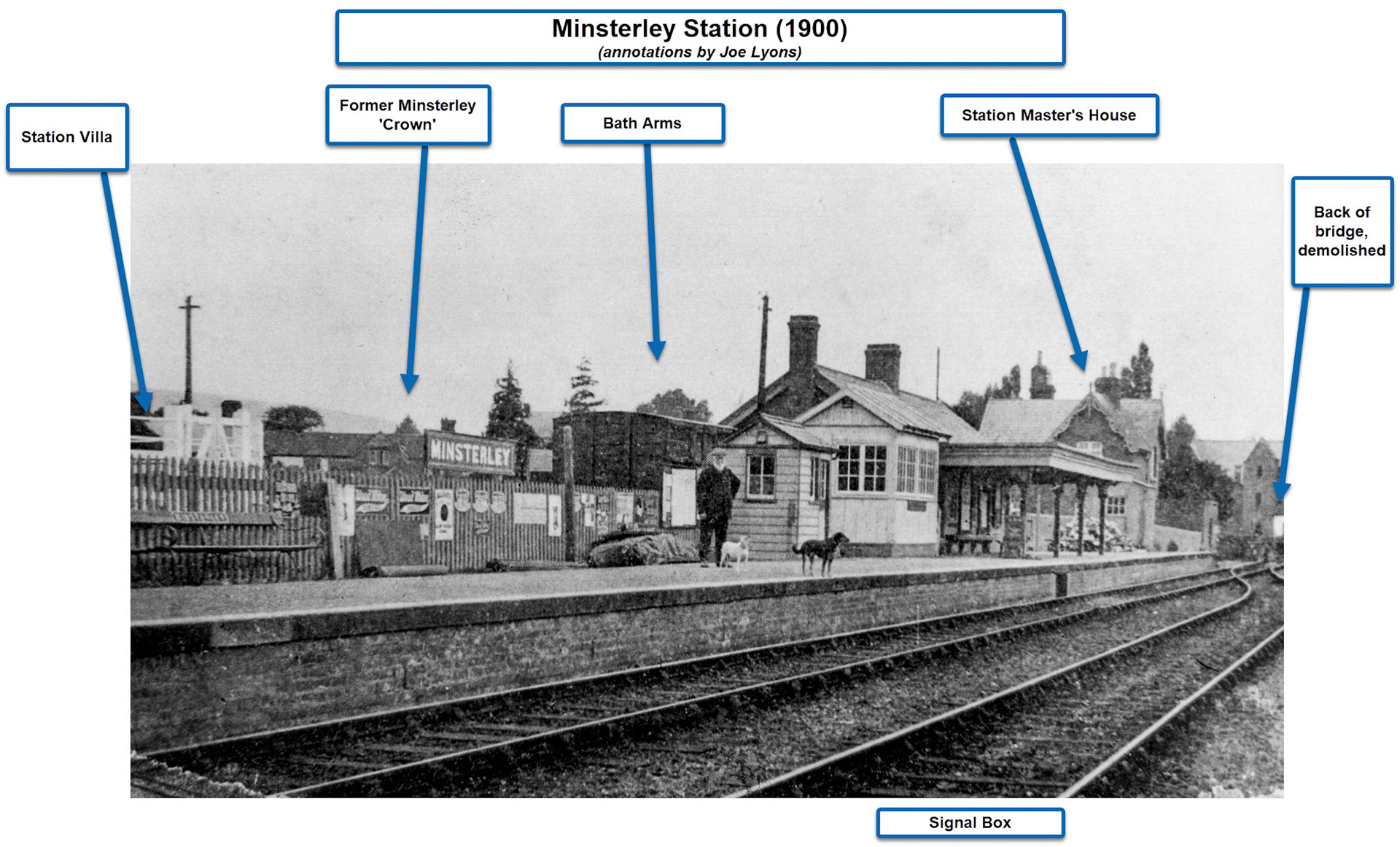
Minsterley Station in 1900, annotated by Joe Lyons.

1902 Euston Station Milk Dock (Courtesy 'On the Milk Train' video, Dr David Turner)

1902 'The Midnight Milk Train at Paddington Station', chalk drawing by Fred Yates. From 'The Milk Supply of London' H. Swan

1902 Vauxhall Station Milk Platform (Courtesy 'On the Milk Train' video, Dr David Turner)

1903 Milk arriving at Paddington Station, London. (Courtesy Mary Evans Picture Library)

1909 4-Wheeled Siphon, No 1503, built to diagram O9 and designated for milk traffic. (Courtesy STEAM - Museum of the Great Western Railway)

1911 Waterloo Station (Courtesy Simon Wilkins, Old London Photos FB)

1914 Vauxhall Station Milk Platform. By this time, only 2% of milk came from urban dairy herds in London. (Courtesy 'On the Milk Train' video, Dr David Turner)

1920's? Billingshurst Creamery, erected in the late 1920's, was the first country depot to be built by Express. Norman Dudman comments "Express Dairy was on the site now occupied by the flats at the end of Brookers Road. My uncle in the 1940s and 1950s delivered milk in churns to Express from Rosier and Daux farm, by horse and cart via Daux Road." Paul Bryant adds "After Express Dairy closed it was Beverly Engineering, there was still the loading bay when I worked there in the 1970-80's." Jeremy Bagley comments "My mum Elsie Howard, sister, worked at the dairy. An Italian POW also worked at the dairy, they married and went to live in Italy.". Nick Thompson added "My dad worked there for over 30 years. It closed down in 1965 when the milk collection went over to tanker rather than churns." Albie Napper comments "My Mum worked there too, Anne Gray".

1920's? Paddington Station. Matthew Pinto comments "The coaches in that photo look standard gauge; my guess is the photo is circa 1920's." (Courtesy ruralhistoria.com)

1920's Paddington Station, collecting milk churns. (Courtesy STEAM - Museum of the Great Western Railway.)

1920's? Loading churns, thought to be on Platform 1 at Paddington Station. (Courtesy RuralHistoria FB Group)

1920's Baschurch Railway Station, where milk was handled for Ruyton Co-operative Dairies. (Courtesy Lin Keska)
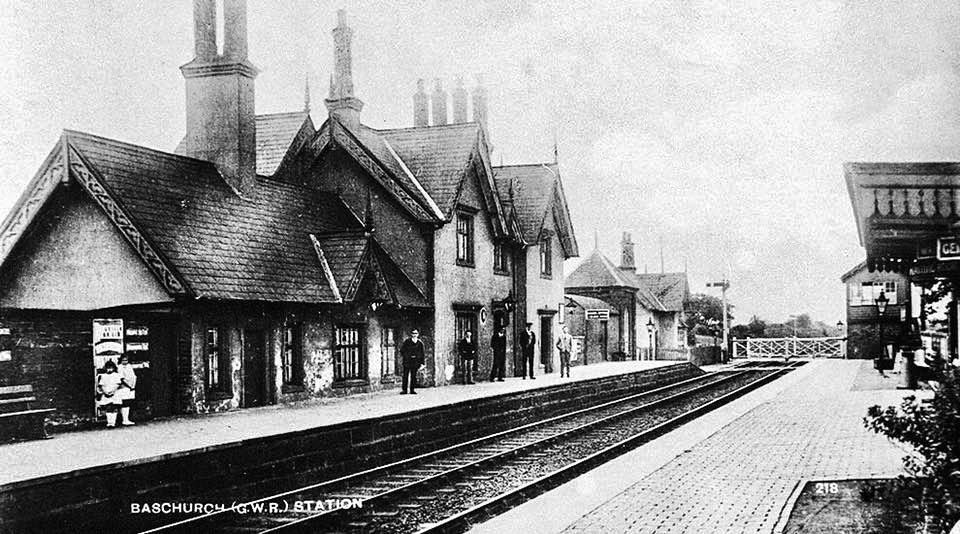
1920's Baschurch Railway Station, where milk was handled for Ruyton Co-operative Dairies. (Courtesy Lin Keska)

1921 "Former Minsterley Station" Glyn Jones comments "I was there the day that crane was cut down, around 1965" (Courtesy Joe Lyons)

1923 8-Wheeled Siphon G, No 1359, built to diagram O11, designated for milk traffic. (Courtesy STEAM - Museum of the Great Western Railway)

1923 GWR map of Oswestry area, with Express Creameries marked. (Original courtesy Michael Armstrong-Smith)

1925 Uttoxeter Station (Courtesy Museum of English Rural Life/ Getty Images)

1926 - Milk Churn Handling at Clapham Junction

1928 Highbridge Station, Somerset. The milk churns in this photograph are empty, having just been dropped off by a departed train. Highbridge station opened in June 1841 and is now known as Highbridge and Burnham. (Courtesy STEAM - Museum of the Great Western Railway.)

1928 Highbridge Station, Somerset. Milk churns sit on platform barrows having just been dropped off by the dairies. They await an incoming train to pick them up. Highbridge station opened in June 1841 and is now known as Highbridge and Burnham. (Courtesy STEAM - Museum of the Great Western Railway)

1929 GWR 4-Ton Thornycroft Lorry, seen here using lifting/ lowering mechanism to lift milk churn from trailer. (Courtesy STEAM - Museum of the Great Western Railway)

1929 Hygiene and speed, Milk Train Express. Matthew Pinto identifies "Wooton Bassett. The tanks are all matching GWR 4-wheelers so probably around the time of opening in 1927." (Illustration from 'The Milk Trade, A Comprehensive Guide to the Development of the Dairy Industry' edited by C Raison (Virtue, c 1933).
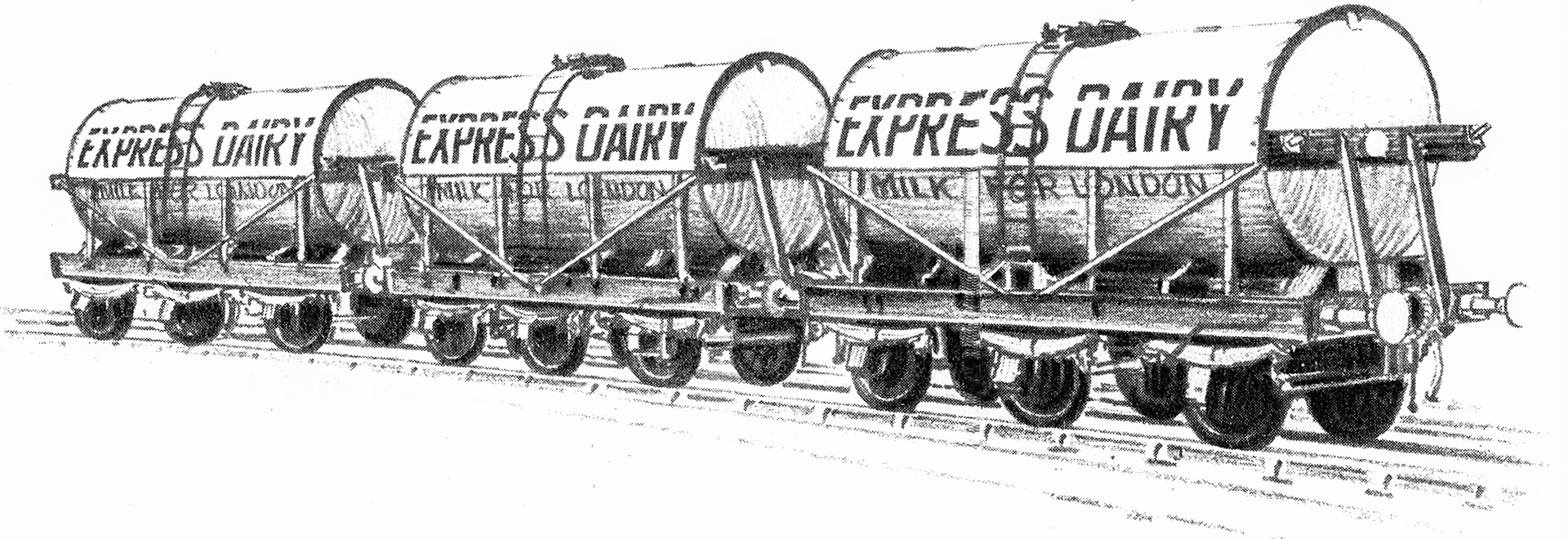
1930 Cricklewood Opening Brochure Illustration-Rail Tanks

1930 Cricklewood Opening Brochure Illustration-Unloading Churns

1930's Appleby Matthew Pinto comments "... must have been taken shortly after opening as the railway siding has not yet acquired its roof. Early 30s at a guess." (Courtesy David Rooke)

1930's Henry Edwards Road-Rail Tank, built to LMS pattern 1989,operated from Pipegate Creamery. (Courtesy Matthew Pinto, Milk on the Rails, Photo: Glen Woods)

1931 Express Rail Tank. Matthew Pinto comments "One of the very first 6-wheeled milk tanks built by the London, Midland and Scottish Railway for Express Dairies (earlier rail tanks were 4-wheeled and rode very roughly at high speeds). It is shown here at Cricklewood depot. Note the semi-cylindrical sunshade. These were common on early tanks but their effectiveness was questionable and the feature was eventually abandoned." (Courtesy Richard Gaylard)
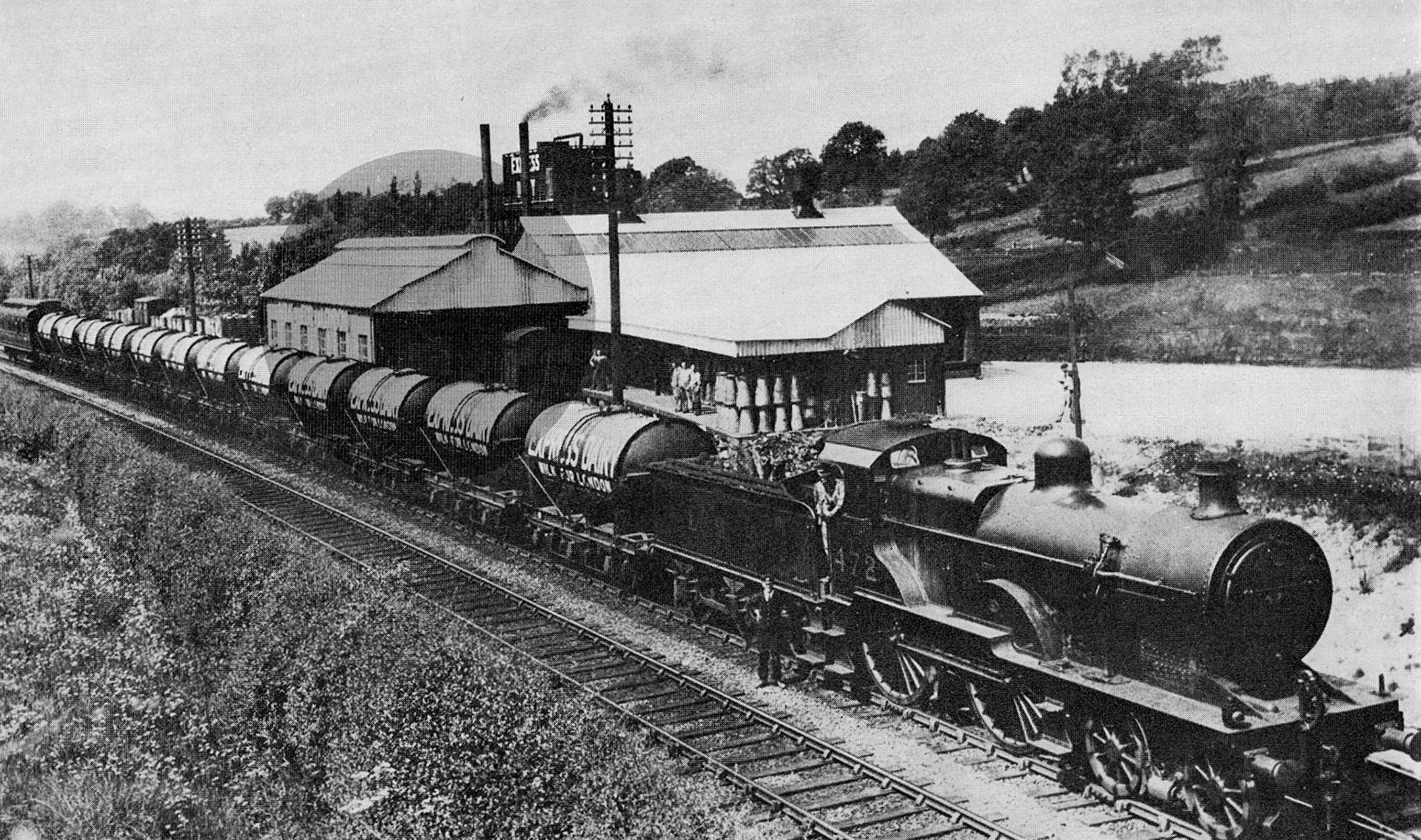
1931 Appleby Rail Siding, reproduced in Express News Christmas 1975. Locomotive 472 pictured is an LMS Class 2 designed by George Ivatt, originally built from 1884 - 1901, and rebuilt in this form between 1912 and 1923. Darwin Smith comments "Most milk trains were run at Express Passenger speeds. The first milk tank wagons built in the 1920s had four wheels. Following some derailments it was decided that these were unstable at speed and milk tanks began to be built with six wheels. Eventually older four wheel wagons were all rebuilt to have six wheels. The first six wheel tanks built for the LMS were delivered in 1931. The picture may well be posed to show these new wagons. (They are all very clean and the number of wagons would probably have been the total number delivered for Express Dairies use in that year. Further wagons were delivered in subsequent years and older four wheeled wagons were converted to have six wheels.)"
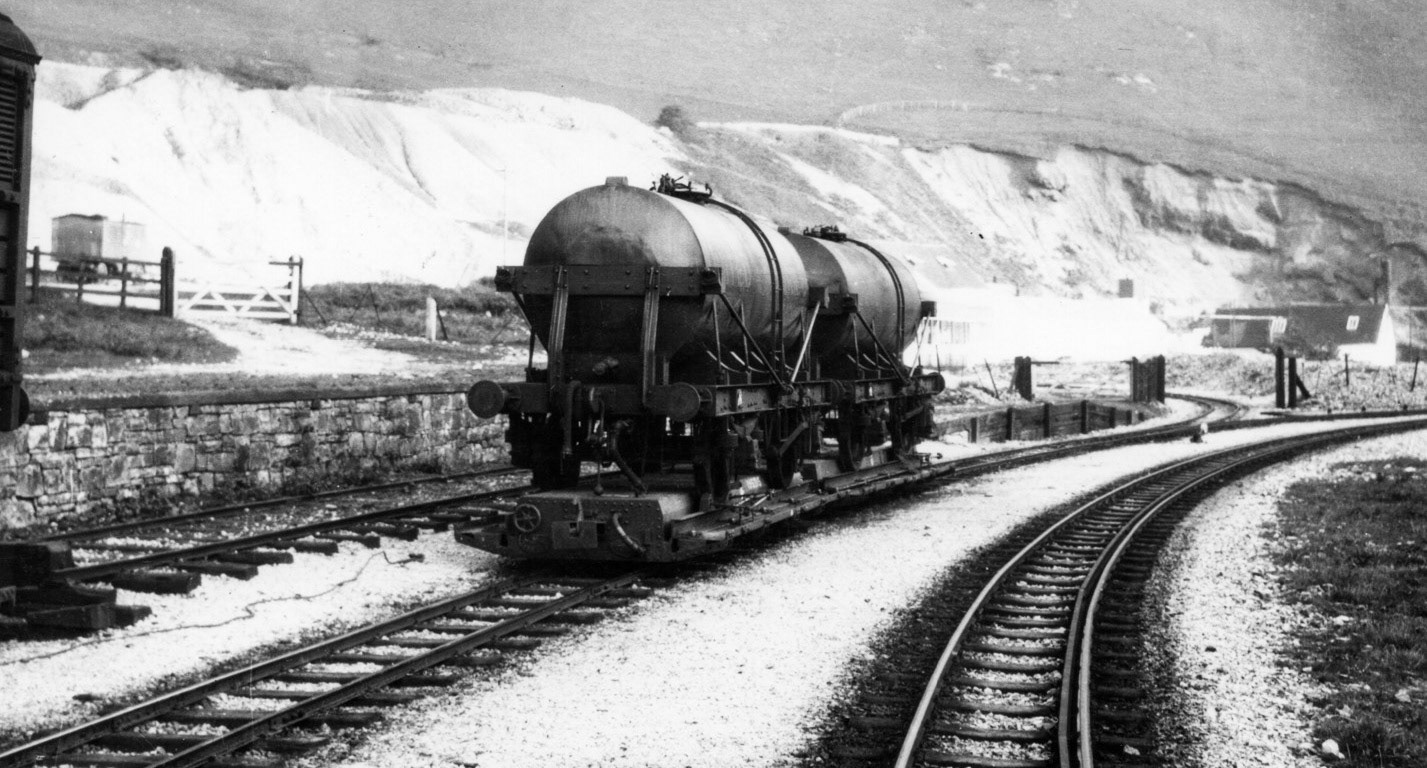
1930's Mainline gauge rail milk tanker at Ecton on a narrow gauge transporter wagon. Alan Salt comments "Farmers and contractors would bring milk to Ecton, some may have been used to make cheese but when excess milk was available (or when liquid milk was worth more to the Company) these tankers would take the milk to Waterhouses then on to Manchester or London. Wilts United Dairies, who ran Ecton, were doing similar at their Uttoxeter site and these rail tanks could well end up at Uttoxeter for onward travel." John Irish adds "I think these tankers were attached at Uttoxeter to the London milk train and then travelled to the large dairy at Finsbury Park." (Courtesy Alan Salt)

1930's Ecton Creamery. Matthew Pinto comments "These tanks were 2000 gallon built by the LNER to diagram 121 in 1930 for United Dairies (most milk tanks were 3000 gallon). Ecton was the only place in the country (possibly the world) where standard gauge milk tanks were filled while perched on top of narrow gauge wagons. The creamery opened as an independent business in 1918 and was later absorbed into United Dairies. Initially it dispatched milk in churns to the UD depot at Finsbury Park. United Dairies closed the Ecton creamery in 1932 and the line itself closed in 1934 as it relied heavily in the income from the dairy traffic." (Courtesy Matthew Pinto)

1932 Express Rail Tank Matthew Pinto comments "One of the original batch of 6-wheeled tanks built by the Southern Railway for Express Dairy in 1932. Note the central supports for the tank which was unique to this batch and replaced with the more familiar end supports in later batches. I can't quite make out the number but this would have been 4410-4413." (Courtesy Richard Gaylard)

1933 Rowsley-filling milk tankers for transportation to London. Bill Conquest comments "The road tanker was new to Express in 1933 so the dairy would have not long opened". (Courtesy Jim Wilson)

1933 Loading Churns for London. Matthew Pinto believes Uttoxeter. Alan Salt comments "I'm pretty certain it's Uttoxeter-you can just make out "Wilts United Dairies on the truck and the end of the word Uttoxeter-I also think the man pointing is Mr Dainton who was the Creamery Manager." Illustration from 'The Milk Trade, A Comprehensive Guide to the Development of the Dairy Industry' edited by C Raison (Virtue, c 1933).

1934c Bradford Model Dairy 2000 gallon demountable tank and flat-wagon. LNER Wagon1734, in chocolate brown livery. Phil Baxter "Can anyone remember the milk train that ran along and above Bowling Back Lane to the Model Milk dairy-it became a scrap yard in the 70s?" (Courtesy Matthew Pinto, Milk on the Rails)

1930s West Park Dairy, based at West Park Farm in Market Lavington had six milk tanker wagons which ran milk from Wiltshire up to London on the Great Western Railway. (Courtesy Market Lavington Museum)

1933 Cricklewood visit of the Duke of Kent visit

1933 Glass-Lined Milk Tank. Matthew Pinto comments "Interesting milk tank, one of just 3 built by the SR with a unique "central vice" design. This photo also shows a famous mis-paint as the tank was actually numbered 4410 but several promotional photos exist of it running as 4401 (which was actually an older 4-wheeled tank). Illustration from 'The Milk Trade, A Comprehensive Guide to the Development of the Dairy Industry' edited by C Raison (Virtue, c 1933)

1936 Southern Railway 12 Ton Ventilated Goods Van S48367, built in Ashford Carriage & Wagon Works. "Arrived on Swanage Railway in 2000 after initial preservation at the Kent & East Sussex Railway. In service for 18 years at Swanage before the latest overhaul began in 2022, and our team of volunteers have turned this wagon out in “Express Dairy Company” colours to replicate one of the three similarly designed SR vans to carry this striking blue livery. More information on S48367 can be found here: http://srstock.co.uk/getfile.php?mode=view&id=952"

1940's? Express Rail Tank (Courtesy Richard Gaylard)

1940's? Express Rail Tank (Courtesy Richard Gaylard)

1940 The Great Western Railway became dominant for milk transport, in 1899 it brought in 23.9 million gallons of milk into London (just over half of all supplies). This picture shows GWR 'Siphon G' bogie gangwayed milk van, 2926, built in 1940. (Courtesy 'On the Milk Train' video, Dr David Turner)

1943 Express Rail Tank Matthew Pinto comments "Milk tank 2445 built by the London North Eastern Railway for Express Dairy in 1943. This was later renumbered 70569 in BR days." (Courtesy Richard Gaylard)

1944 Express Rail Tank Matthew PintoMilk tank 4444 built by the Southern Railway for Express Dairy in 1944. I suspect that this photo is taken shortly after nationalisation due to the presence of the board with 3 stars on it. These were supposed to be fitted to goods wagons to indicate what speed they could run at. Milk Tanks were not actually goods wagons and were classified by the railways as NPCCS (Non Passenger Carrying Coaching Stock). As such they should not have been fitted with these boards as they were cleared to run at express passenger speeds but a handful were fitted with boards by over-enthusiastic fitters. 😉 (Courtesy Richard Gaylard)

1946 Express Dairy 3000 Gallon Milk Tank, No. 1970, built in 1946 to diagram O54. (Courtesy STEAM - Museum of the Great Western Railway)

1946-8 Test your railway knowledge by finding the mistakes in this picture, from the Great Western Trust archive. (Courtesy Didcot Railway Centre FB)


1948 Rossmore Road. Bulleid Light Pacific entering Marylebone, with milk tankers at Rossmore Road (Independent Dairies) in the background. Matthew Pinto comments "I think this was taken during the Exchange trials in 1948. Bulleid Pacifics were not a common sight at Marylebone." (Courtesy https://www.geograph.org.uk/more.php?id=2650927)

1950's? Appleby (Courtesy David Rooke)

1950's? Appleby (Courtesy David Rooke)
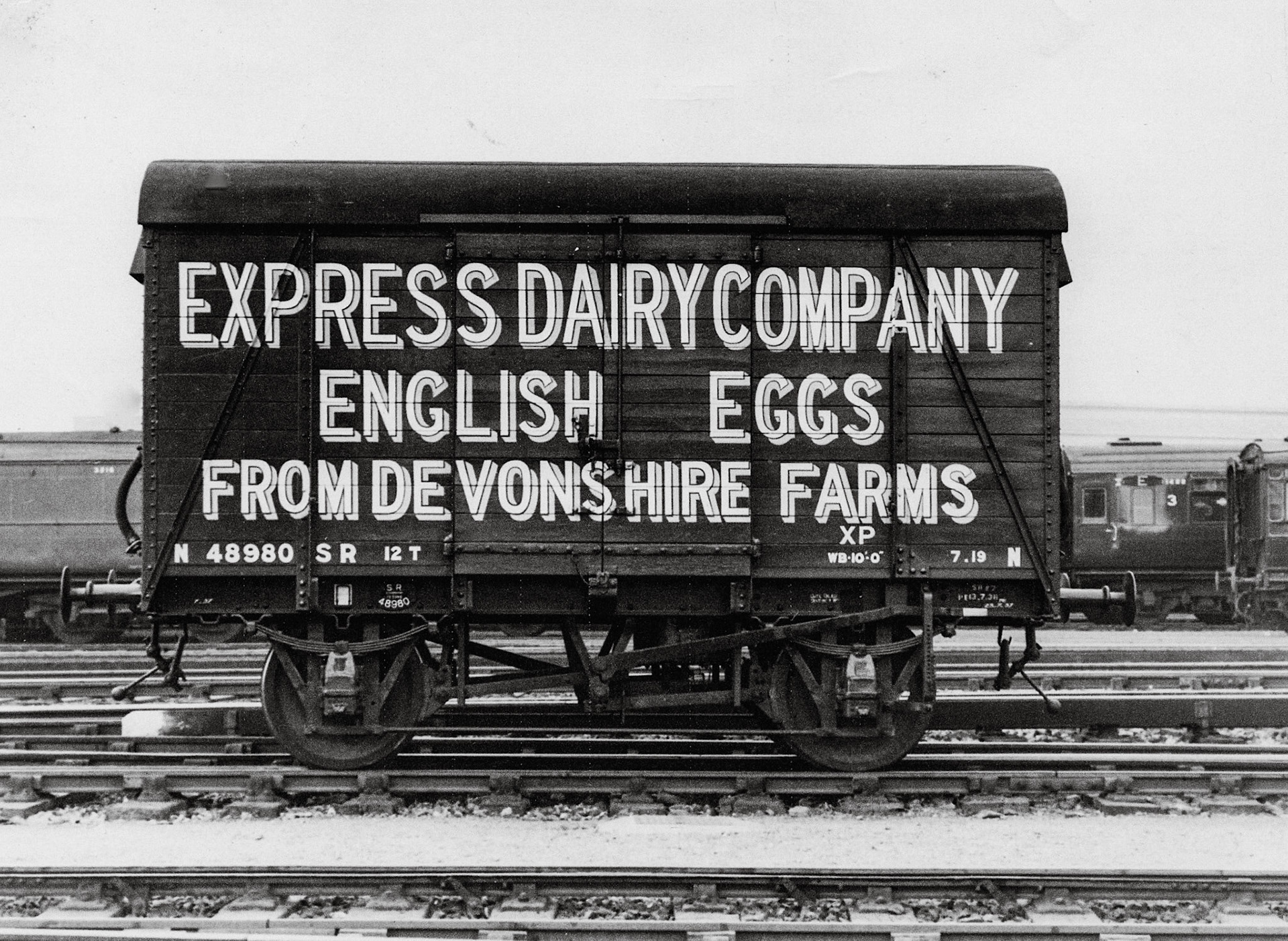
1950's Egg Transport - Eggs for London. James Ayres explains "The wagon is a Southern Railway design made of planks on a steel frame and roofed with felt. Its loaded weight was 12 tons. The letter N at each end of the frame indicate it was fitted with vacuum brakes. They were not of a standard design so the wagon could not be used for freight by rival companies and had to be returned to the Southern. As this particular unit, the property of the Express Dairy, was probably configured inside to accommodate its fragile load it doubtless spent at least half its life running empty. " (Courtesy Keith Sweetland)

1950's? South Morden (From Express Milk for London-John Hosegood)

1950's? Minsterley Creamery Rail Siding (From hydey44, Flickr)

1950's? Minsterley Creamery Rail Siding (From Lorraine Fletcher, Facebook)

1950's ? 73117 heading the Down milk empties near Fleet. John McIvor

Minsterley (Courtesy Karen Osman)
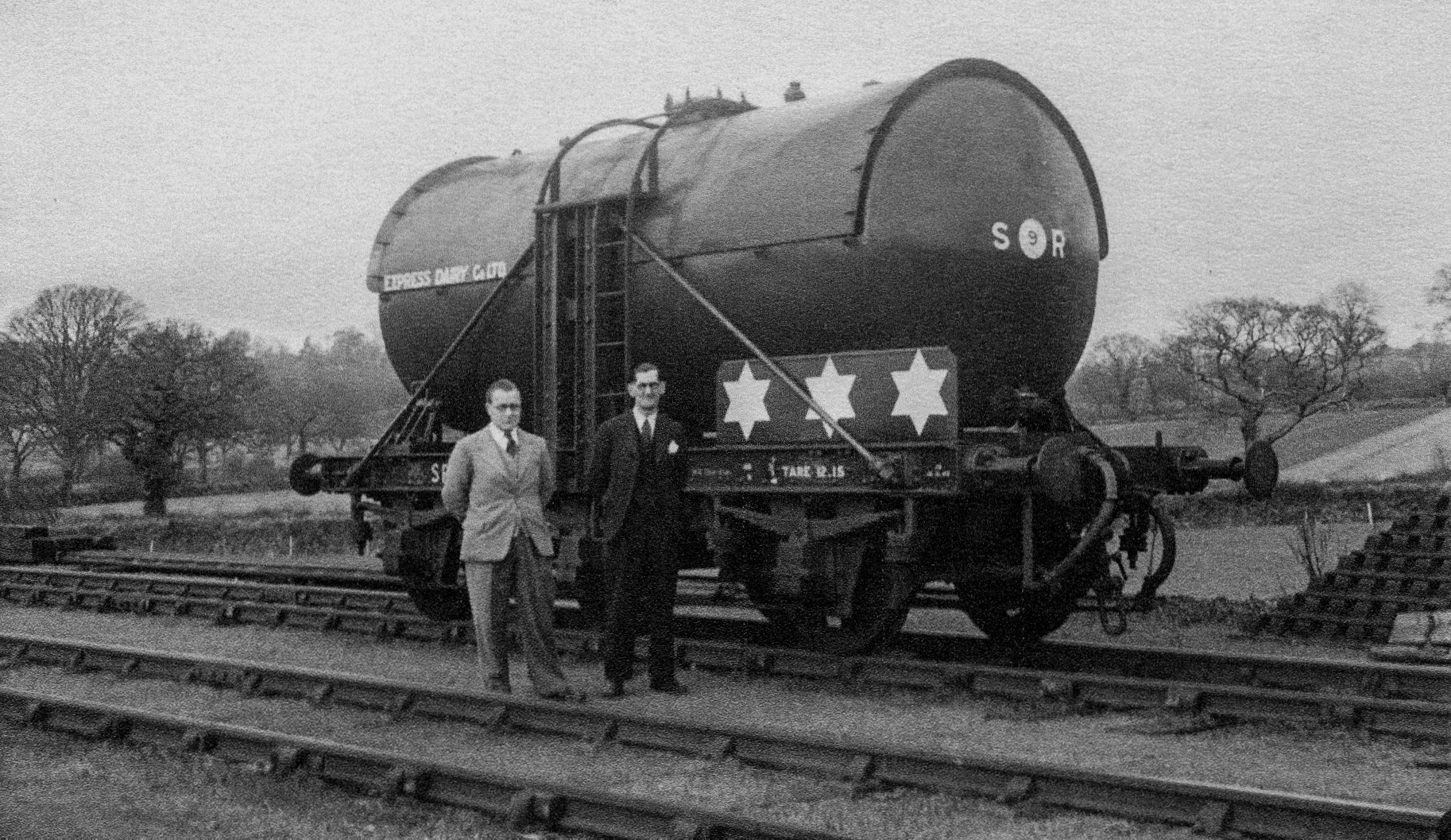
1950's? Seaton Junction (Courtesy Keith Sweetland)

1950's ? Aerial view of Cricklewood Dairy and marshalling yard (Courtesy Sue Smith, FB)

1950's ? Churn Collection

1950's? G.W.R. Churn from Baschurch Railway Station, Kraft Dairies. (Courtesy Lin Keska)

1952 'The Express Dairy' Booklet, colour rendering by Leo Saunders (September 2025)

1954 Pipe Gate Station, near Woore in North Shropshire. Closed to passenger services in 1956, next to Express Pipegate Creamery which had its own siding for delivering milk as far away as London" (Courtesy Steven Harley)

1954 South Morden Processing 'Express Halt' rail siding. (Stills from Express Dairy Film)

1954 South Morden Processing rail siding. Space for 2 x 7 tanks (14) under cover, and four additional outside. (Stills from Express Dairy Film)

1954 South Morden Processing rail siding. Space for 2 x 7 tanks (14) under cover, and four additional outside. Tanks could be discharged and cleaned from any position. (Stills from Express Dairy Film)

1954 South Morden Processing rail siding. Three additional tanks being shunted outside, with the dairy's own shunting engine. Coal wagons on the left for the boilers, coal-fired at that time. Roger Frost comments "The coal wagons were unloaded with a big hand-held scoop that was pulled along by a winch cable that was controlled by the operator. Hard to describe but very efficient in its operation." (Stills from Express Dairy Film)

1954 South Morden Processing shunting engine. Raffaele Ralph Phillips comments "Poor old 'David'; I worked on both shunters whilst employed as a vehicle electrician in the maintenance garage 1970-88." (Stills from Express Dairy Film)

1954 South Morden Processing. Agitating and sampling from a rail tank. (Stills from Express Dairy Film)

1954 South Morden OS Map 1-1250 showing track layout in rail siding. (Courtesy National Library of Scotland)

1955 South Morden, from 1989 Express 125 Year Anniversary Review
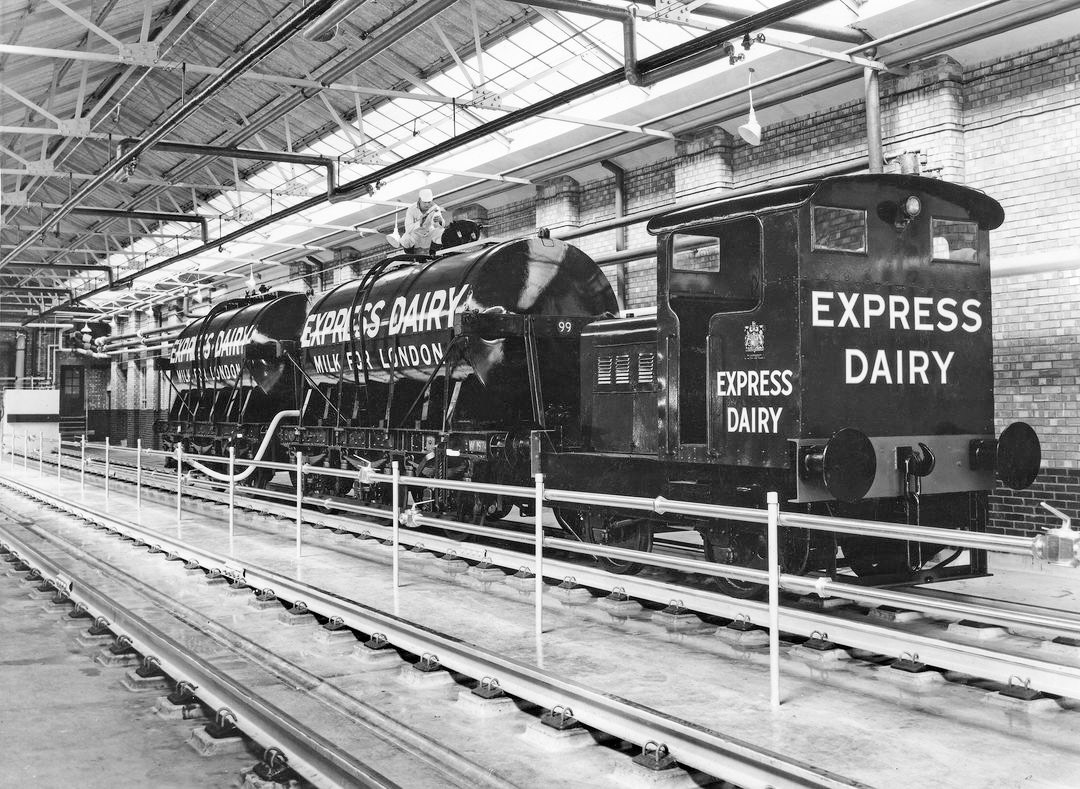
1955 South Morden. Jimmy Reid posted this picture, and comments "This is how we got our name from the trains that delivered bulk milk to depots and plants across the country." Colin J Marsden also commented "When I was a young secondman at Waterloo, a regular turn was to go on the Morden Milk, taking a few GW 6-wheel tanks round in the morning and going to fetch them early afternoon after off-loading. Quite often the morning inbound train was worked through by Western men. Over the years I took a number of pictures at the milk terminal and one day one of the older staff came over with a black and white picture taken at the depot in 1955. He said 'you can have this, this is what it was like here in the 50s'. I carefully preserved it and today I've scanned it. I do not know the details of the loco, but he said it was taken the day it was delivered to the facility. (Courtesy Colin J Marsden and Jimmy Reid) Poor quality version also published in Express News July 1956

1955 Minsterley Station. David Giddins comments "Had a canopy then. an SLS Special that travelled all the branch lines of Shropshire, behind the sole remaining GW Dean Goods loco at the time. It is in post nationalisation condition, after 1948." (Courtesy Colin Middleton, Pontesbury past and present FB Group)

1956 August, 41298 at Torrington on the 4pm service to Halwill Junction. The tankers for the 4.37 p.m. departure are being loaded behind the goods shed and the van for that train waits at the platform. Photo: Peter Gray.

1956 South Morden station and rail reception. Matthew Pinto comments "Interestingly there appears to be a 50's LMS Stannier full brake coach in one of the dairy sidings. An interesting find so deep into Southern Railway territory." (Courtesy Bill Rudd, Mitcham Historical Society)
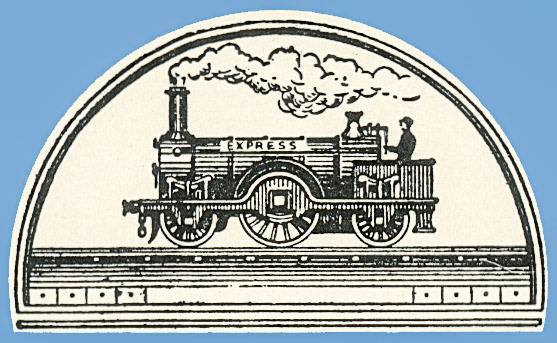
1957 Express Logo from Compliments slip

1958 Evening milk train at South Greenford Halt, hauled by 4077 Chepstow Castle. The tankers are returning from Kensington to the West Country empty. Michael Dembinski comments "Leaver Gardens is to the west of the line, photo taken from the 'Up' platform." Bill Dewdney adds "The milk train went through South Greenford Halt around 10pm nightly. If I wasn't home by then, I was in trouble!" (Courtesy Christopher Slatford)

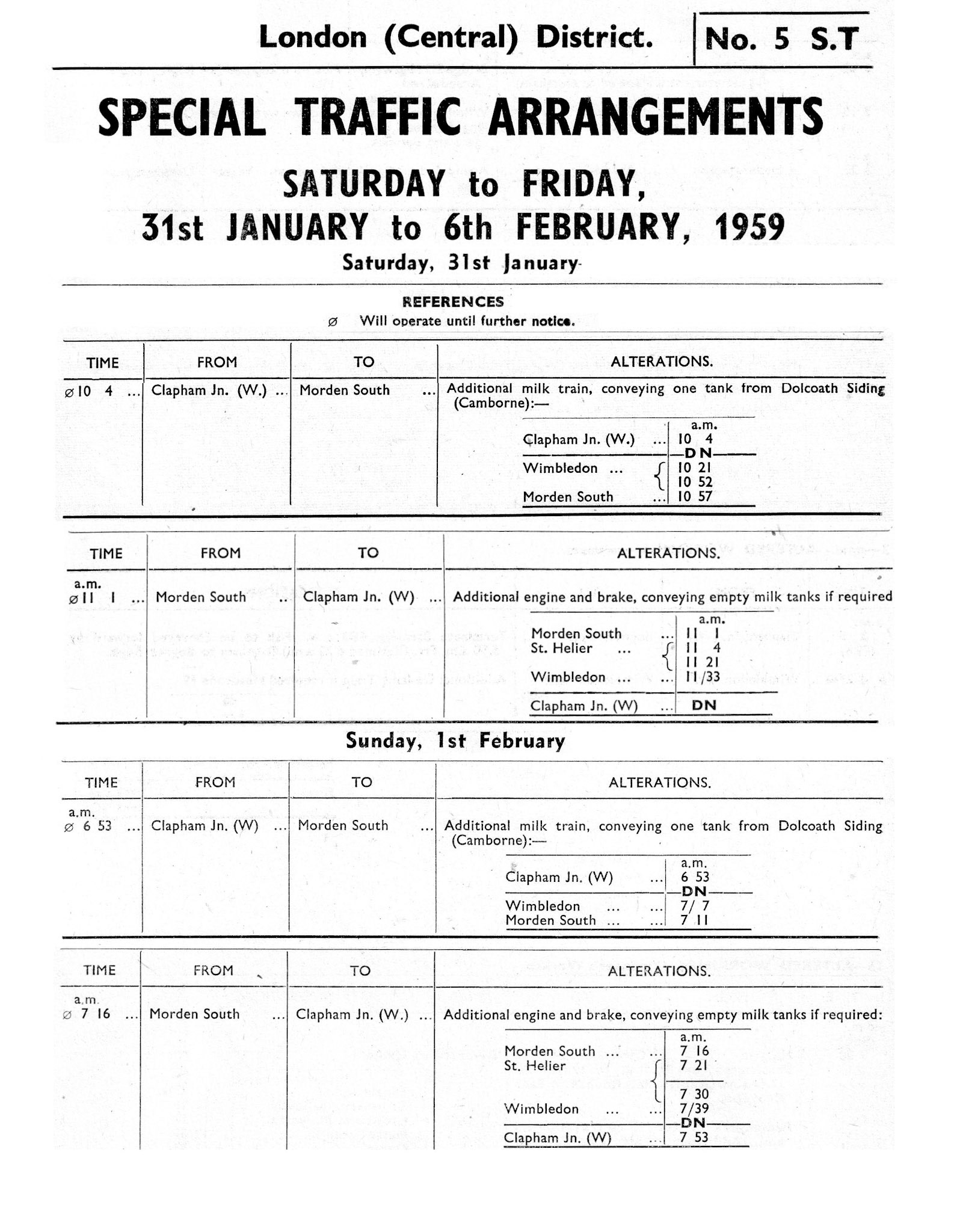
1959 Milk delivery schedule by rail

1960's ? Typical card that was clipped to each rail tanker. This one for a consignment from Seaton Junction to Cricklewood, via Clapham Junction. (Courtesy Leslie Croxford)

1960's Rail Tanker return label, Felin Fach. On arrival each wagon had a card clipped to a spring-loaded holder on the chassis. These were private-owner wagons that needed to be returned empty to the right creamery, hence these cards...Peter Roper comments "We received milk regularly from Felin Fach at South Morden in the 1970's. In the summer it was unfortunately necessary to reject many complete tankers because the milk had gone sour in transit. This was done with a simple COB test ('Clot on boil') i.e. the milk went solid when a sample was heated in a test-tube. In this case, the MMB was notified and they would instruct us to add a specified quantity of soda ash to the tank, to prevent the contents going solid. It was then returned to the creamery for milk powder. (Courtesy Peoples Collection Wales - Michael Morgan)

1960's Rail Tanker return label, Felin Fach. (Courtesy Peoples Collection Wales - Michael Morgan)
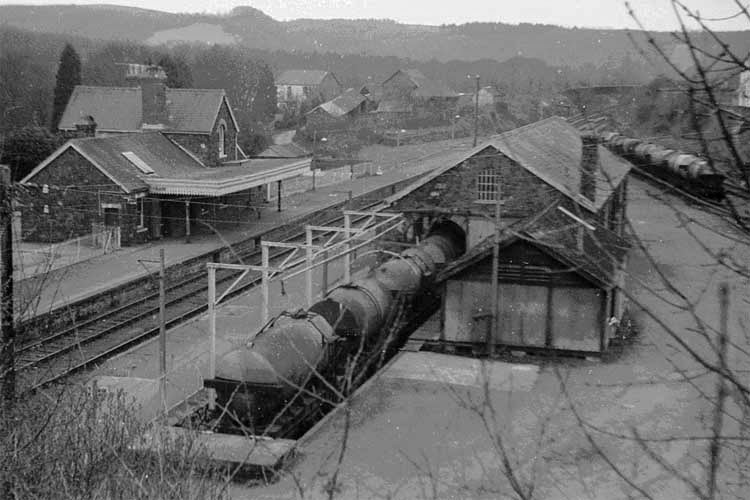
1960's The 2.47 p.m. and 4.37 p.m. trains of milk tankers at Torrington. This image clearly shows the loading gantries to the left of the tankers. Only three tankers could be loaded before the first one reached the buffer stops. Photo: Nigel Brodrick

1960's? Minsterley Rail Siding (Courtesy Karen Osman)
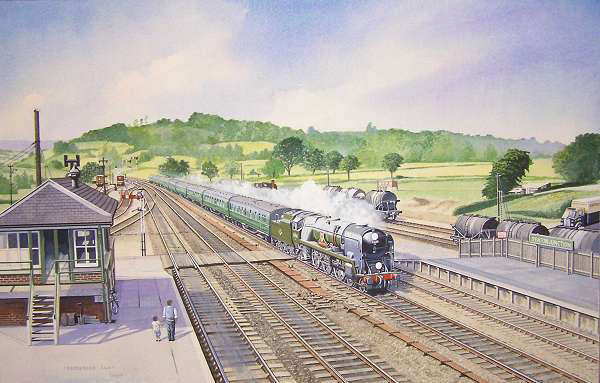
1960's? Seaton Junction station (Courtesy Keith Sweetland)

1960 'Sir Aglovale' (courtesy B Lewis)

1960's Bulleid 'Spam Can' hauling the Plymouth to Morden South, Express Dairy milk train through Wimbledon Park Station. (Courtesy Robert Carroll/ Robin Beard)

1960's? South Morden, Matthew Pinto comments "A Ruston Hornsby 48DS shunter which was resident at Morden from its opening in 1954 to 1972." (Courtesy Richard Gaylard)

1960's South Morden, Express Rail Tank (Courtesy Richard Gaylard)
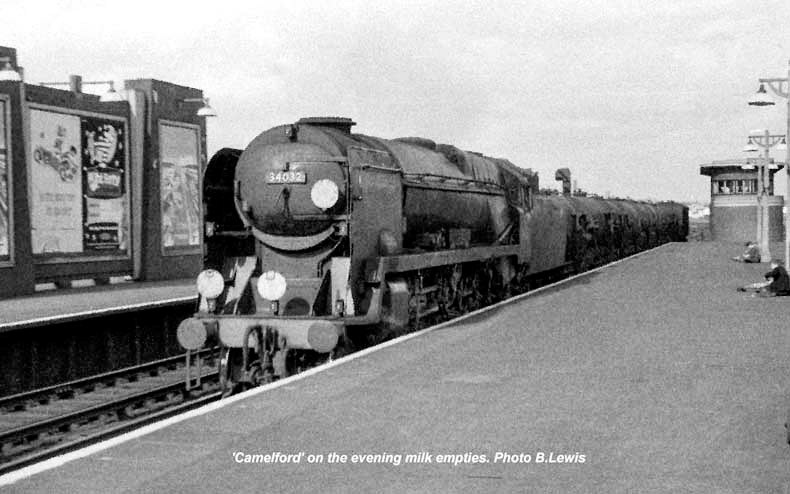
1960 'Camelford' on the evening milk empties (courtesy B Lewis)

1960's Express Tanker Reg PXV 964 (Courtesy Michael Aldread)

1960 Minsterley Station, Station master was George Jones. Peter Power commented on the Disused Stations FB Group "Closed for passengers 5/2/1951 and permanently in 1967." (Courtesy Joe Lyons)

Minsterley Station in 1960, annotated by Joe Lyons.

1961 South Ruislip-Reprint from Dairy Industries journal

1961 South Ruislip Rail Siding - Reprint from Dairy Industries journal

1962 Ruston & Hornsby 0-4-0 diesel locomotive at the Express Dairy bottling plant, Morden South. Mike Morant comments "The picture was taken from the window of a passing EMU whilst travelling towards Sutton from Wimbledon in September 1962." Peter Roper comments "Driving it, and its successor, was fun-I did it several times. You had to anticipate the (lack of) braking, especially when shunting full wagons. The two unloading bays took 14 tanks, 7 each side. But on some nights we might receive up to 18. On one famous occasion, a member of staff let it run off the catch points, partly blocking the Wimbledon line 😮. I had to phone the signaller, urgently!!" (Slide taken by Mike Morant, courtesy Paul Smith)

1962 winter. "Driver Jack Socket escaped with a twisted ankle". Patrick Taylor comments "The unfortunate man behind the wheel was Mr Jack Socket, I dont believe that he was seriously injured. At that time the railway virtually split the site in half, when carriages were shunted to factory carrying coal for the boilers-which were coal fired at that time. Products such as cheese, condensed milk, and butter were loaded directly onto the wagons and taken by train to distribution points. I think the last train to use the line for transporting products in and out of Minsterley was between 1965/6." (Courtesy Joe Lyons)

1963 Morden South Station (Reproduced from The Railway Magazine December 1966)

1963 Seaton Junction, from Cornwall Railway Society - "S15 30842 stands by the signalbox with an interesting train and waits at the down platform. An extremely long footbridge carries a public footpath not only over the four track main line at this location but also over the branch platform. Looking between the front of 30842 and the signalbox the Seaton branch engine, on this occasion 6412, stands at the branch platform. 11th September 1963 Copyright Mike Roach."

1963 Milk Marketing Board (W1) 6wheel milk tank W1993 at Kensington Olympia (Historical Model Railway Society)

1963 United Dairies 6 wheel milk tank 2837 in train at Kensington Olympia (Historical Model Railway Society)

1964 Seaton Junction (Courtesy Matthew Pinto) Jane Shepard comments "My Dad did some brick laying on the egg packing factory when I was two or three, about 1950. I remember Dad forgot his sandwiches for lunch so Mum and I caught the train up from Colyton to Seaton Junction and we sat on the embankment eating our lunch - remember like it was yesterday. We used to catch the train to Seaton too, to go to the beach - no bus service to speak of back then."

1964 Seaton Junction (Courtesy Matthew Pinto) James Ayres (FB) comments "The lorry is a Ford Thames Trader built in various sizes between 1957 and 1965."

1964 'Dr Beeching's closed your station...' (Fleet Flash magazine-October 1964 No 7, Page 5)

1965 South Morden rail siding, with BR 75078 locomotive. 75078 was built at Swindon in 1956 and as it was built for use on the Southern Region it was fitted with a BR1B tender which had a capacity of 4,725 gallons, because there were no water troughs on the Southern Region. It was equipped with a double chimney in October 1961. (Courtesy Bill Rudd, Mitcham Historical Society)

1965 Instow, Devon. Class 25, 7575, renumbered 25225. Tony Dairywell comments "Loaded milk tanks from Torrington depot, probably headed for West Ealing." (Courtesy Ken Baker)

Type 2 loco nearing Fremington, passing Penhill, with Barnstaple in the background. Paul Arnthal comments "Milk and clay empties to Torrington and Meeth." (Courtesy Ken Baker)

1965 An overall view of Torrington station, shortly after the passenger and general goods services had been withdrawn. Milk tankers bound for London are prominent in the yard. Photo: Nigel Brodrick

1965 All stations to Cricklewood - story of a milk train journey from Seaton Junction to Cricklewood Page 1 (Express News Summer/Autumn)

1965 All stations to Cricklewood - story of a milk train journey from Seaton Junction to Cricklewood Page 3 (Express News Summer/Autumn)

1965 All stations to Cricklewood - story of a milk train journey from Seaton Junction to Cricklewood Page 4 (Express News Summer/Autumn)

1965 "A mechanical glow-worm: an electric hurtles through the night; in the small hours: gathering steam for the last leg at Kensington Olympia' Journey's end: the brightly lit siding of our Cricklewood bottling dairy" (Express News Summer/Autumn)

1965 All stations to Cricklewood - story of a milk train journey from Seaton Junction to Cricklewood Page 2 (Express News Summer/Autumn)

1965 "Starting point: the tree-encrusted pastures of Seaton Junction." (Express News Summer/Autumn)

1965 Seaton Junction. "Piped aboard: 3,000 cool, creamy gallons" (Express News Summer/Autumn)

1965 Seaton Junction. "Minutes to go...and the last job was done. Dairy Foreman Mr Cecil Whiller slotted the last label into the tenth milk tank and straightened his back to look down the length of the train. Each wagon had a capacity of 3,000 gallons — over 29,000 gallons in all." (Express News Summer/Autumn)

1965 "Kensington Olympia was the main terminal point for South London. Here trains were split up for Cricklewood, Morden and Clapham. It was back to Kensington that the empty milk wagons went, to return to the West Country, in great block trains. The West London Line, scarcely known to passenger travellers, ran from Old Oak Common to Latchmere, next door to Clapham. It was the only place on British Railways from which trains could leave for any part of the country." (Express News Summer/Autumn)

1965 Cricklewood Dairy rail siding. (Express News Summer/Autumn)

1965 Appleby Rail Siding. Matthew Pinto comments "This image was taken by Gerald T Robinson. At this date most milk at Appleby was inbound for cheese production." James Ayres comments "The locomotive is an LMS Class 4 designed by George Ivatt built between 1947 and 1952 mainly for light freight work. The characteristic high running-plate was a deliberate decision to aid with cleaning and maintenance."(Courtesy Iain Dargue)

1966 South Morden. Off the rails-the engine was hauling a load of empties, but jumped the points and effectively sealed off the branch siding to South Morden bottling dairy, and prevented a daily 30,000 gallons from getting through. "Fortunately British Rail are used to such mishaps, no one was hurt and the line was cleared for traffc within 48 hours, allowing the milk tanks through again." (Express News Summer)
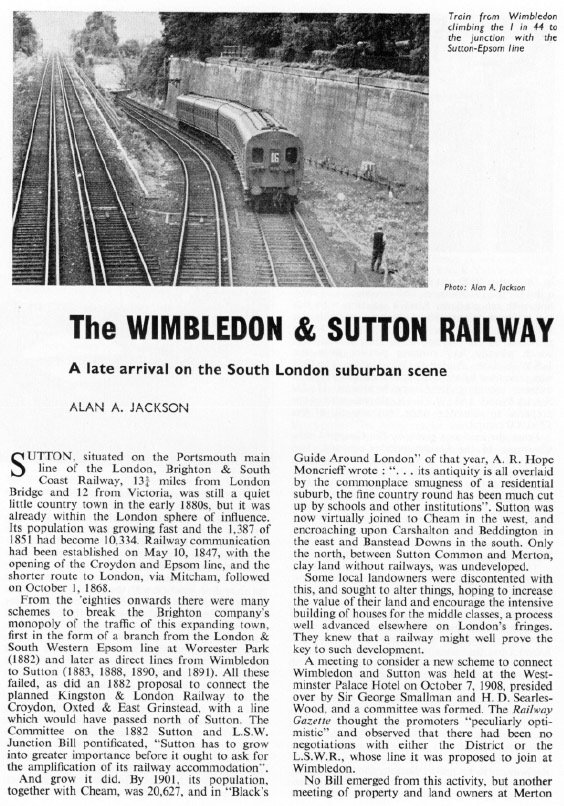
1966 The Wimbledon and Sutton Railway (Reproduced from The Railway Magazine December 1966)

1966 The Wimbledon and Sutton Railway (Reproduced from The Railway Magazine December 1966)

1966 The Wimbledon and Sutton Railway (Reproduced from The Railway Magazine December 1966)

1966 The Wimbledon and Sutton Railway (Reproduced from The Railway Magazine December 1966)

1966 The Wimbledon and Sutton Railway (Reproduced from The Railway Magazine December 1966)
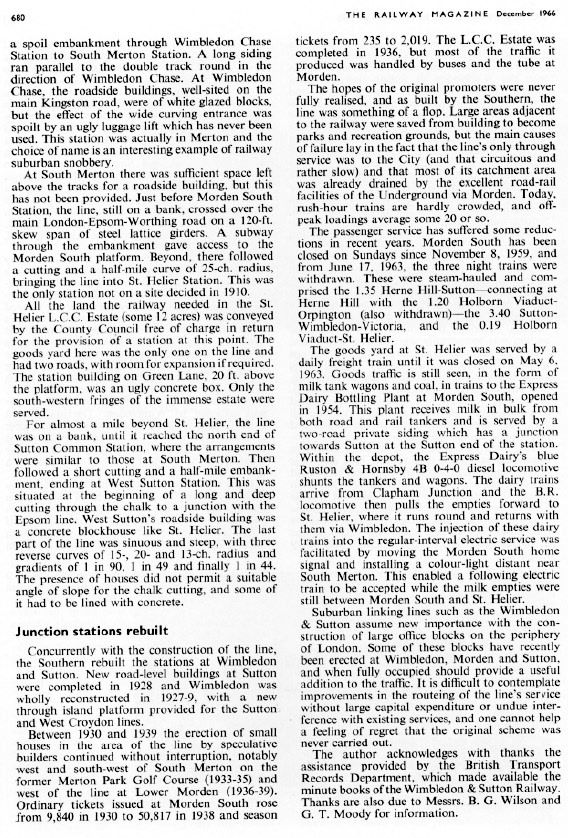
1966 The Wimbledon and Sutton Railway (Reproduced from The Railway Magazine December 1966)

1970's? Seaton Junction Station, with milk wagons in the sidings. (Courtesy Keith Sweetland)

1970's? 25080 arriving at St. David's with the Chard Junction Milk Tanks. Frank Huddy comments in 2024 "Chard Junction milk factory was utterly obliterated about five years ago; nothing remains today, just returned to nature as a meadow beside the River Axe". Matthew Pinto comments "Up until the mid-60s, milk from Chard was worked up the SR mainline. When the lines west of Exeter were transferred to the Western Region, the milk was worked to Exeter and consolidated with tanks worked from further west. They were then worked up the former GWR line to London." (Courtesy Pete Doel)
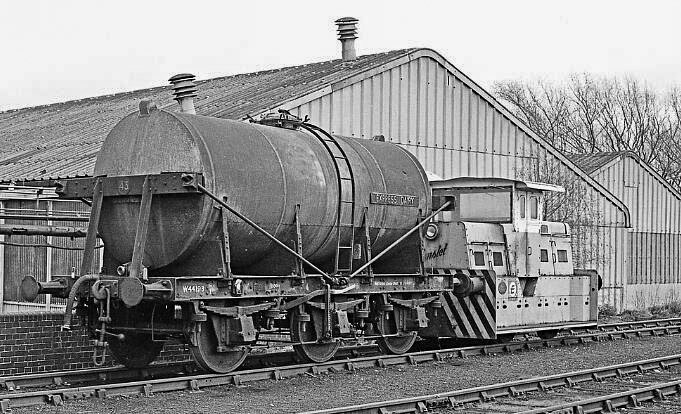
1970's South Morden Rail Siding, with Hunslet shunter.

1970's Hunslet diesel shunter at South Morden rail siding, by refuelling tank

1970's The dairy from Morden South station platform

1970's The dairy from Morden South station platform

1970's South Morden dairy rail siding
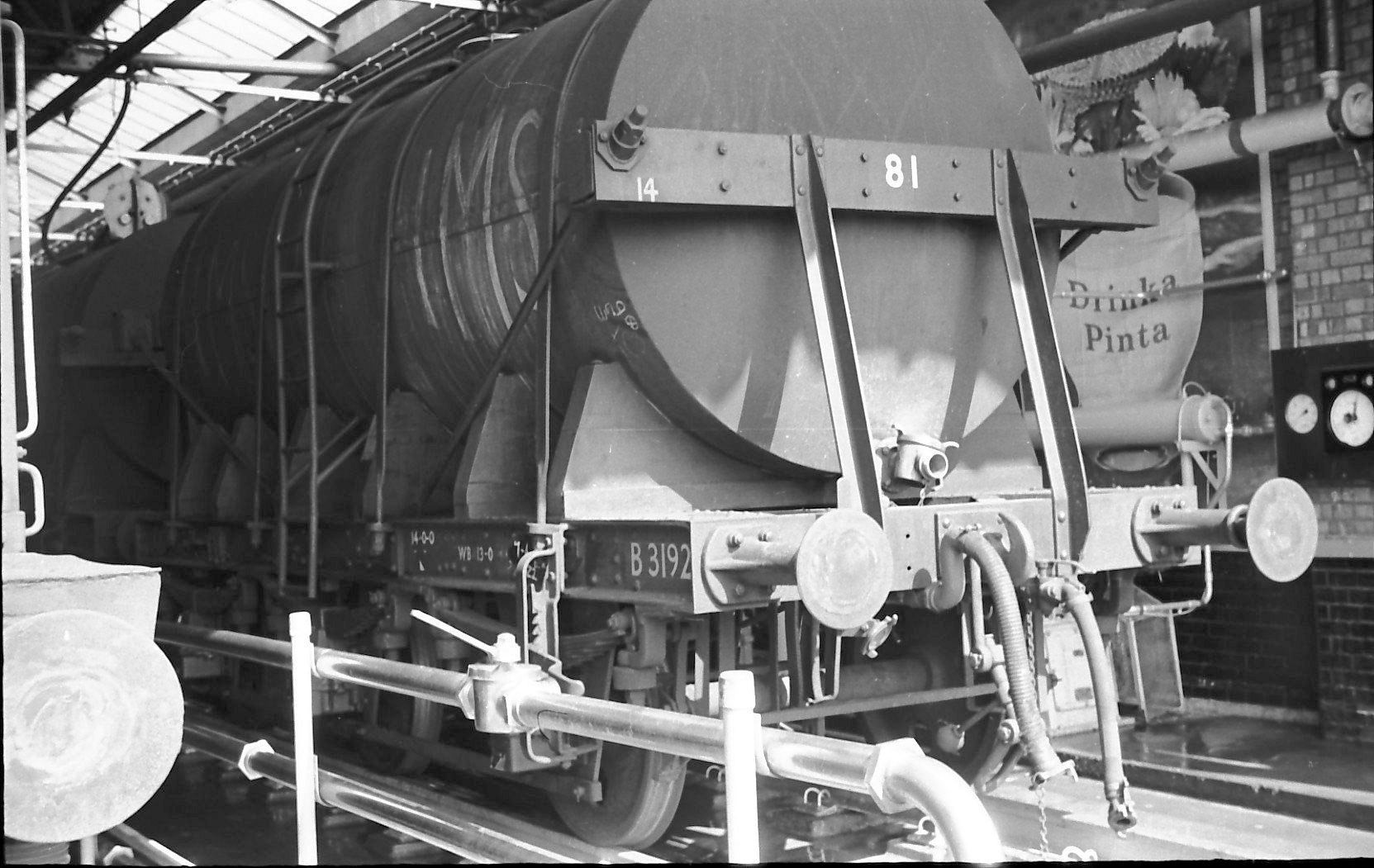
1970's IMS tank at South Morden dairy rail siding. Matthew Pinto comments "GWR Diagram 056 in post-nationalisation IMS livery".

1970's South Morden. Matthew Pinto comments "A Hunslet Yardmaster, which replaced the older Ruston Hornsby 48DS shunter in 1972." (Courtesy Richard Gaylard)
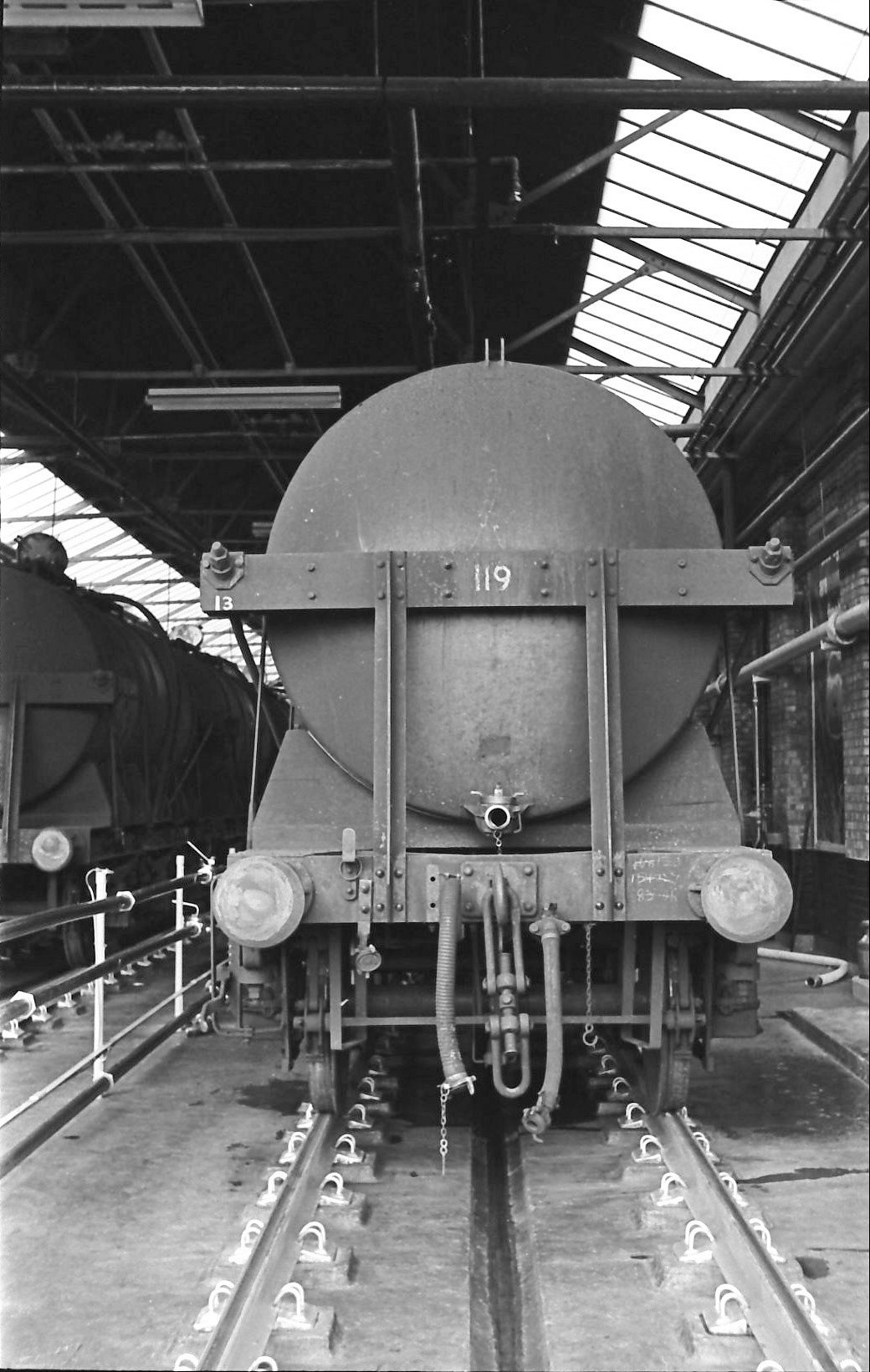
1970's South Morden dairy rail siding

1970's South Morden dairy rail siding

1970's South Morden dairy rail siding-'David' by oil storage tank - tanker at end of same siding

1970's Ruston 48DS 235511 in the rail siding, with milk tanks under cover-probably 14 that day as they are stabled right up to the end of the rail reception bay. (Courtesy Geoff Smith)
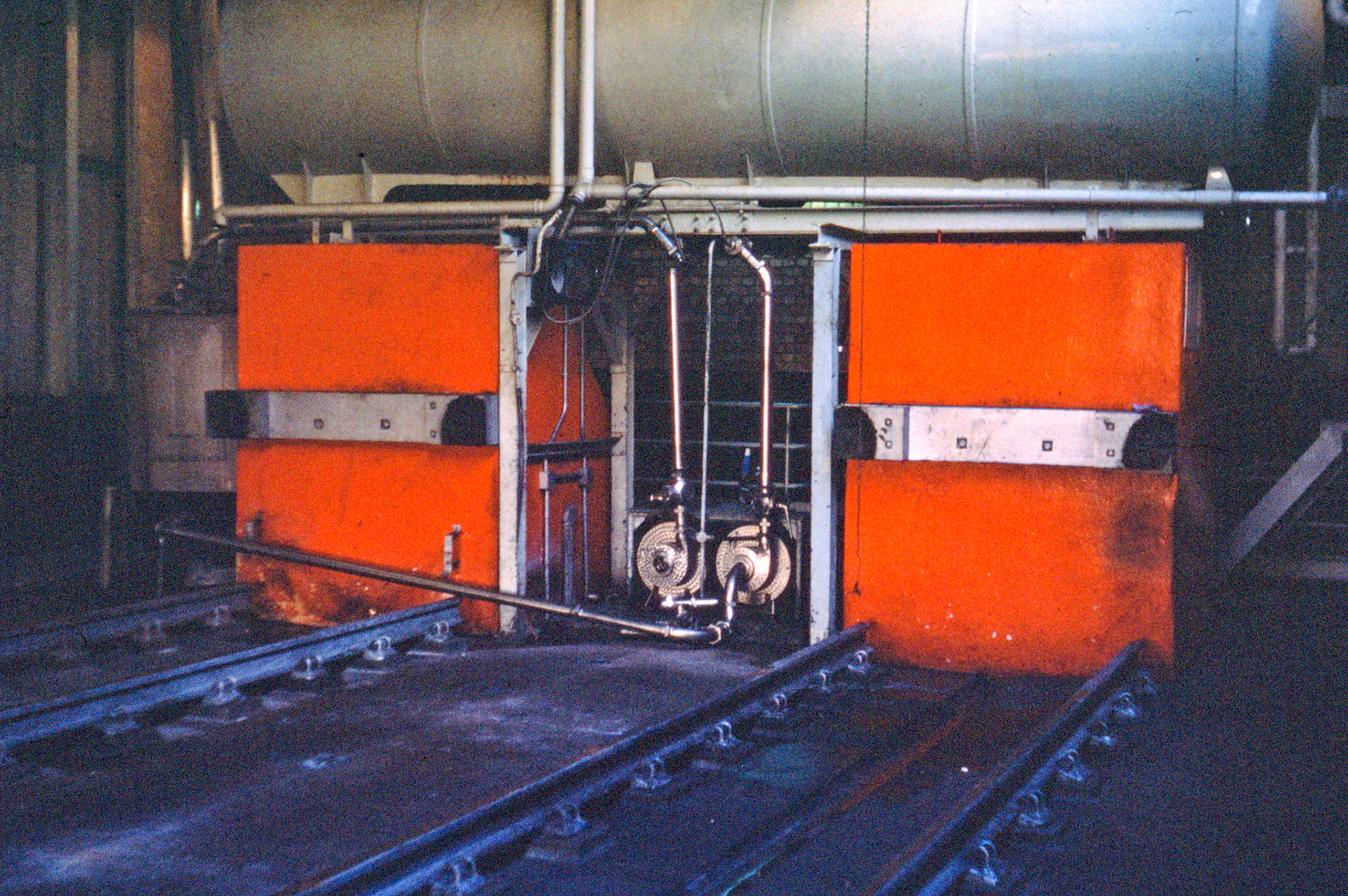
1970's South Morden-Substantial concrete buffers at the end of the rail siding, with CIP tank above, just prior to removal.

1971 South Morden dairy from the station. (Courtesy Robert Carroll)

1975 Cricklewood-The up slow platform buildings with the Express Dairy bottling plant, built in 1929 behind. This was rail connected and had it's own locomotive, a Ruston & Hornsby 4wDM, between 1945 and 1954. Kevin Lane, Flickr
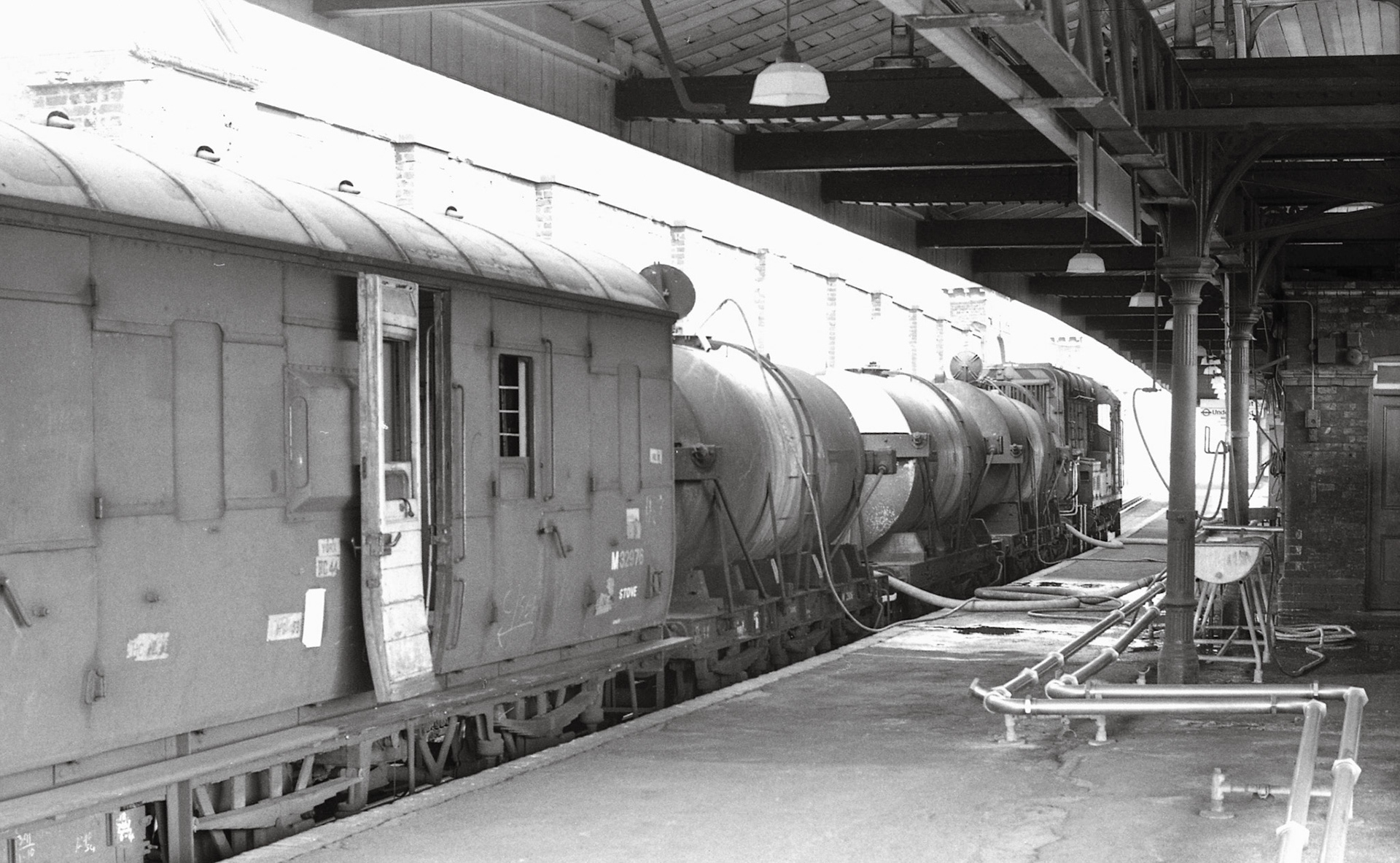
1975 Milk from Torrington being discharged at Vauxhall station on 2 August, the train being shunted by 09:05. Courtesy Kevin Lane, Flickr

1975 Milk dock at West Ealing, viewed from the station platform on 8 March.Courtesy Kevin Lane, Flickr.

1976. Newton Abbot. Chris comments "D1071 WESTERN RENOWN, running through Newton Abbot, on the Kensington milk." (Courtesy Chris Hiley)

1977 Milk was still being received by rail, up to 14 3000 gallon tanks could be accomodated under cover, and more outside in the sidings.

1977 Seaton Junction. Alan Young comments "Up platform which I photographed in August. This station is on the ex-Southern Railway route between Salisbury and Exeter, closed to passengers with several other intermediate stations (and the Seaton branch) in March 1966, but goods continued to be handled here until May 1967. (Courtesy Alan Young)

1979, Old Oak Junction. 31148 caught passing the closed signal box at Old Oak Junction on 19 July. Likely to be empties from Express Dairy Cricklewood, returning to the West Country. (Courtesy Kevin Lane)
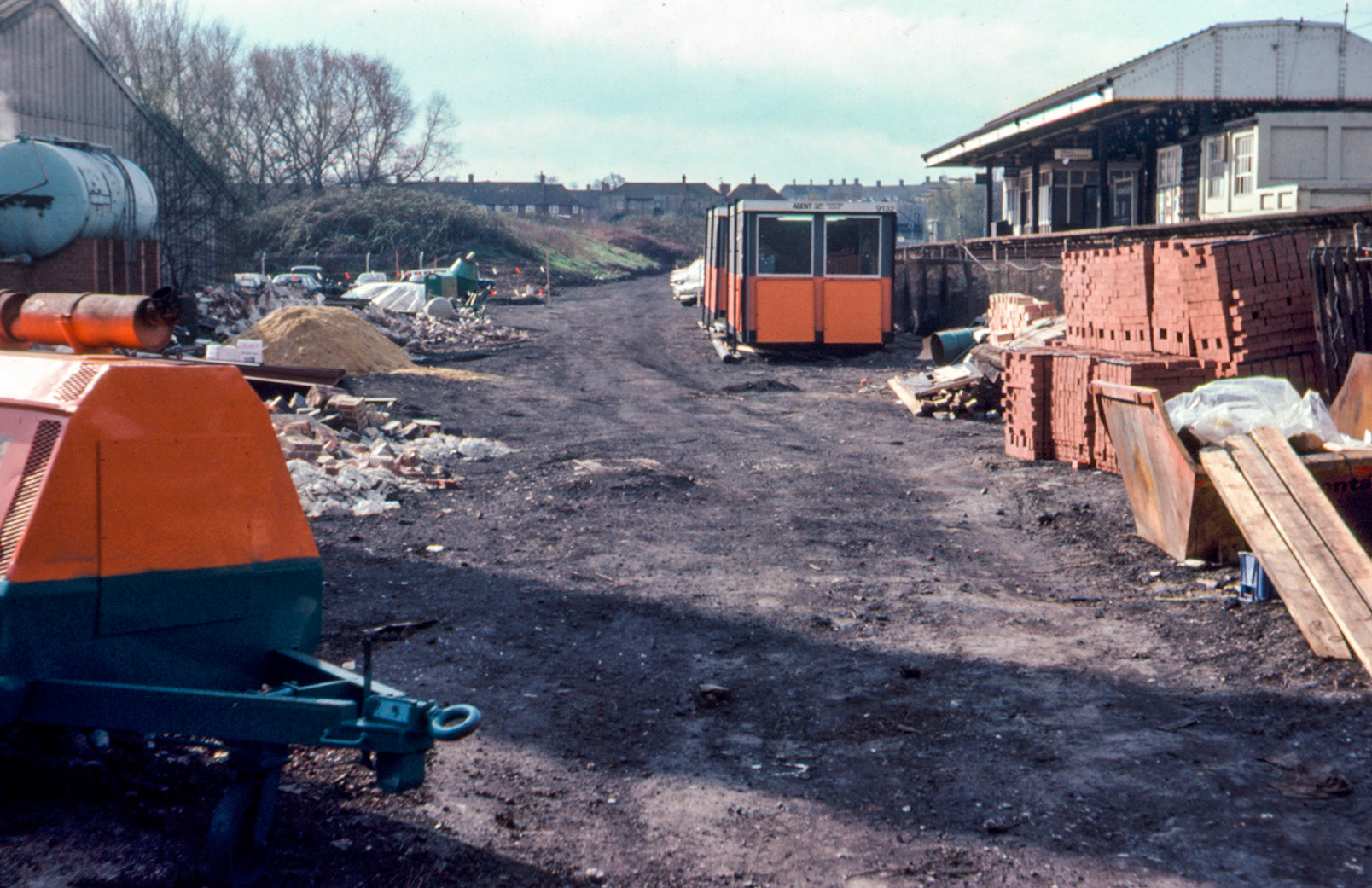
1979 South Morden - old rail siding prior to construction of new boiler house

1980's South Morden Processing from Morden South station (Courtesy Dave Fane)

1982 Express donates rail tanker to Didcot Railway Centre. (Express News April)

1982 GWR Society article about milk traffic. (From Express Milk for London-John Hosegood)

1982 GWR Society article about milk traffic. (From Express Milk for London-John Hosegood)

1982 GWR Society article about milk traffic. (From Express Milk for London-John Hosegood)

1982 Restored tanker 4409 at Didcot Railway Museum. (From Express Milk for London-John Hosegood)

1989 Stratford. Condemned ex GWR Milk tanker W2592, manufactured 1937. (Courtesy Kevin Lane/ Alec Swain)
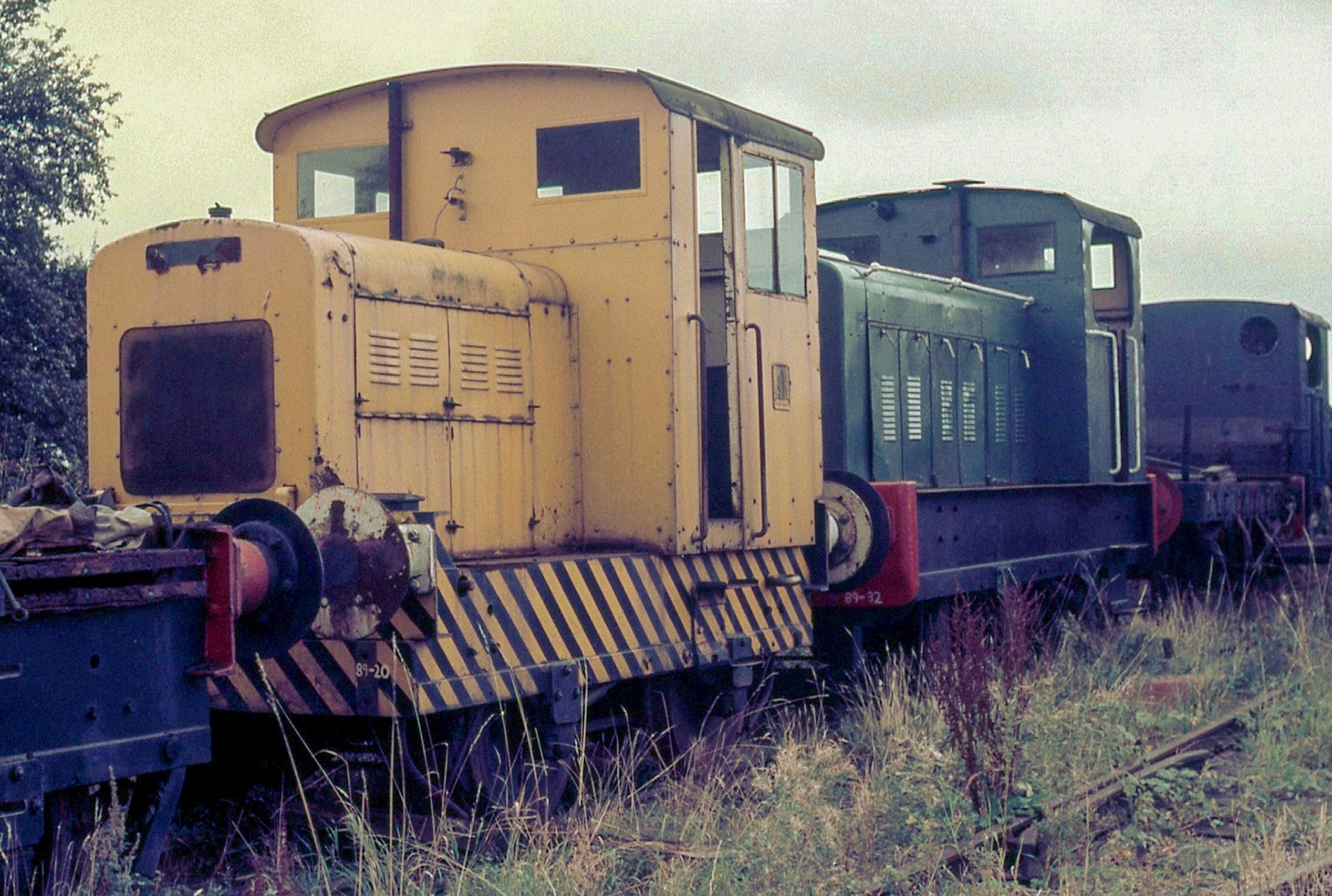
1989 Northamptonshire Ironstone Railway Trust shed at Hunsbury Hill. Murray comments "The yellow Ruston 48DS is 386875 of 1955, which came from British Leyland’s Wellingborough foundry when it closed in 1981, since scrapped. In the foreground is what I believe to be Ruston 48DS 235511 of 1945, supplied to Express Dairy at Cricklewood later moving to Morden. (Courtesy Murray Liston)

2014 - Six wheel 3000gallon milk rail tanker preserved at Didcot (Courtesy 'History of the GWR' - Ian Mackenzie)

Express Rail Tank at Didcot Railway Centre (Courtesy Richard Gaylard)

Express Rail Tank at Didcot Railway Centre (Courtesy Nick Seviour)

2014 The Pendon Paper reprint 'Milk Trains in the Vale of White Horse' (Courtesy Pendon Museum)

2014 The Pendon Paper reprint 'Milk Trains in the Vale of White Horse' (Courtesy Pendon Museum)

2014 The Pendon Paper reprint 'Milk Trains in the Vale of White Horse' (Courtesy Pendon Museum)
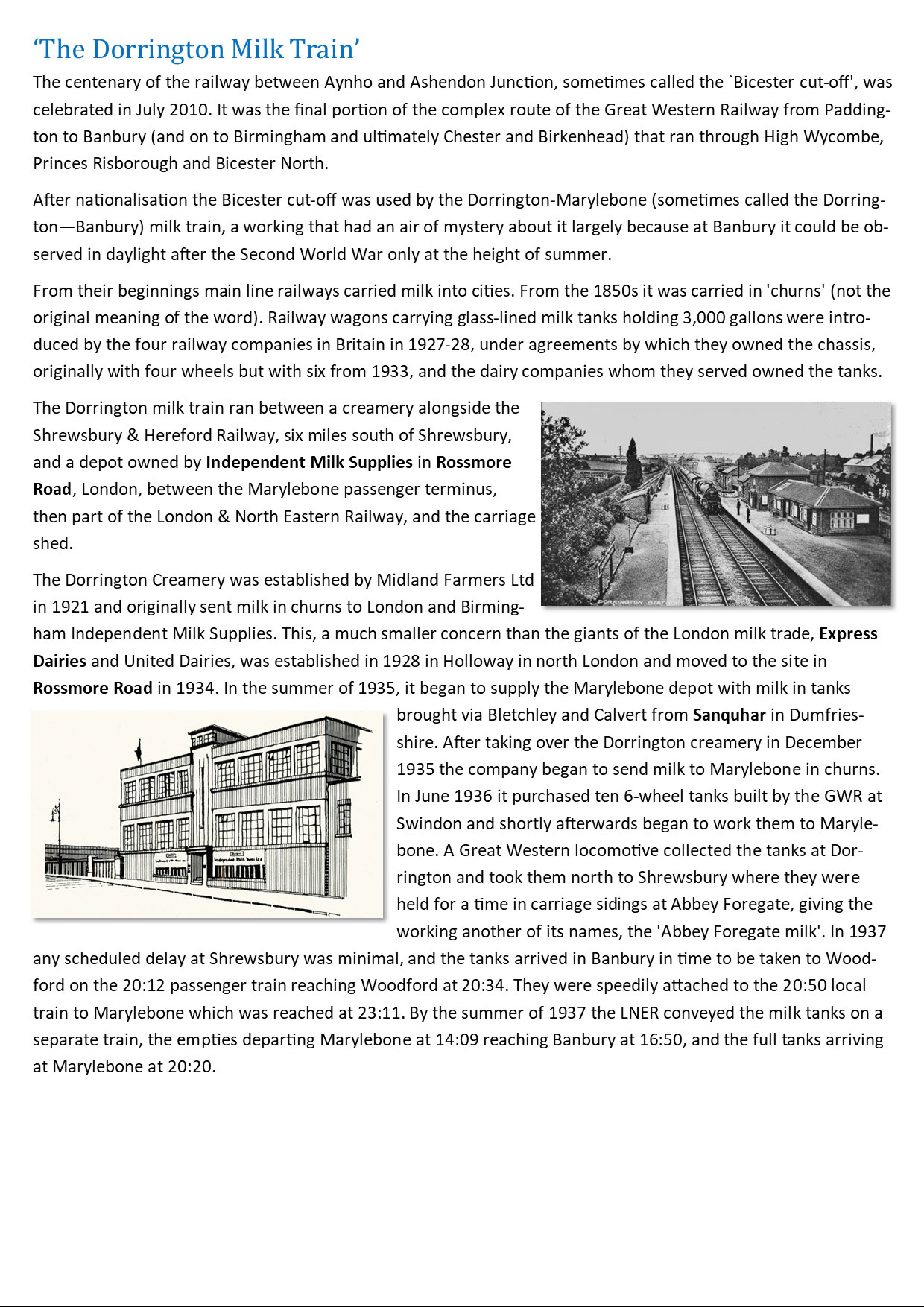
Dorrington Milk Train and Independent Milk Supplies - Page 1

Dorrington Milk Train and Independent Milk Supplies Page 2

2024 Recreation of milk train on the East Somerset Railway. Tom Bailey comments "A scene that hasn't been seen for many years since steam finished in 1964 was recreated last week. This project started as just a discussion and then it became reality. Here we see a steam hauled milk tank being recreated at the East Somerset Railway." (Courtesy Tom Bailey, photo copyright David Kitching)

2024 Recreation of milk train on the East Somerset Railway. Tom Bailey comments "A scene that hasn't been seen for many years since steam finished in 1964 was recreated last week. This project started as just a discussion and then it became reality. Here we see a steam hauled milk tank being recreated at the East Somerset Railway." (Courtesy Tom Bailey, photo copyright David Kitching, converted to Black and White on suggestion by Matthew Pinto "It could almost be the 1950's")
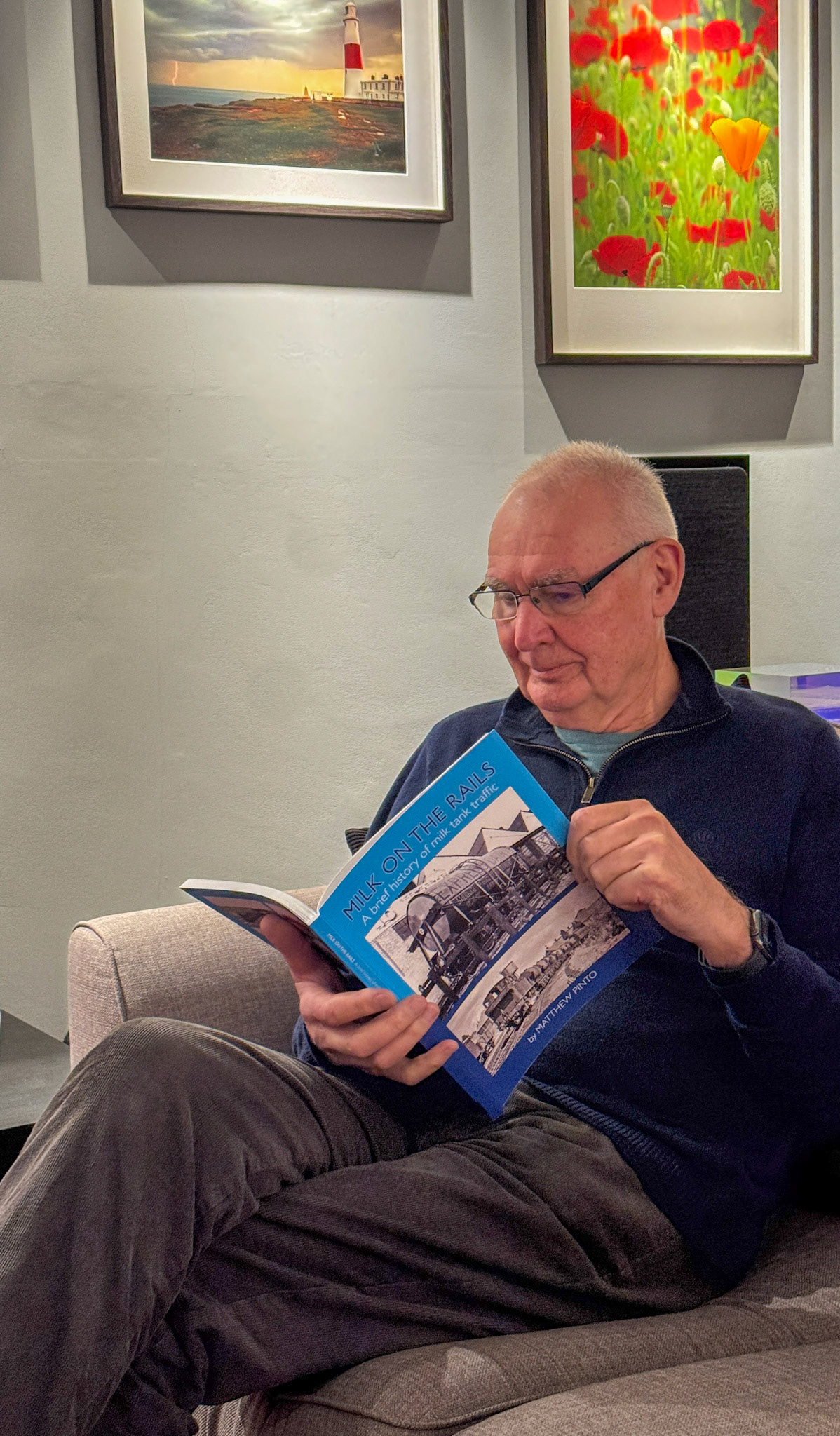
2024 Peter Roper enjoying Matthew Pinto's new book 'Milk on the Rails - A brief history of milk tank traffic'. Superbly written and produced, full of great illustrations, Matt's book is a must for all interested in the history of the milk trade. Express sites featured include Appleby, Billinghurst, Bollo Lane (Acton), Crediton, Cricklewood, Eltham, Faringdon, Frome, Horam, Lapford, Leyburn, Morden, Pipegate, Rossmore Road, Rowsley, Sanquhar, Seaton Junction and South Ruislip.

2024 Peter Roper enjoying Matthew Pinto's new book 'Milk on the Rails - A brief history of milk tank traffic'. Superbly written and produced, full of great illustrations, Matt's book is a must for all interested in the history of the milk trade. Express sites featured include Appleby, Billinghurst, Bollo Lane (Acton), Crediton, Cricklewood, Eltham, Faringdon, Frome, Horam, Lapford, Leyburn, Morden, Pipegate, Rossmore Road, Rowsley, Sanquhar, Seaton Junction and South Ruislip.


